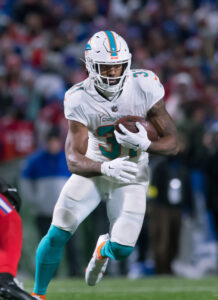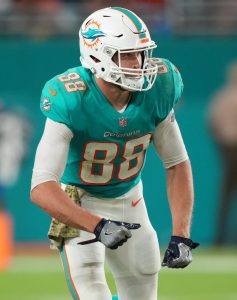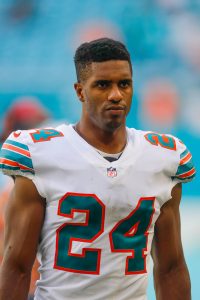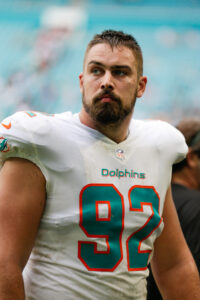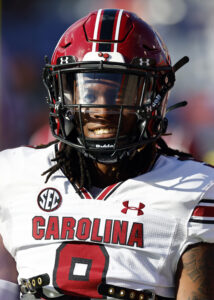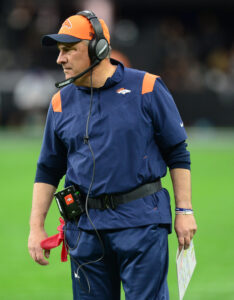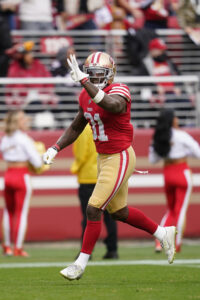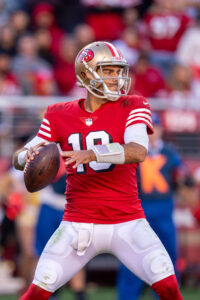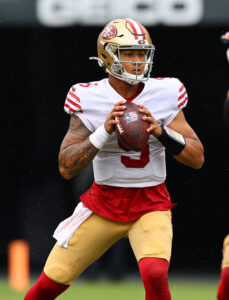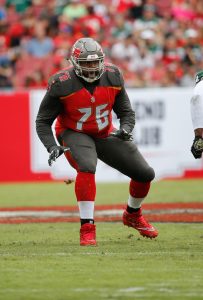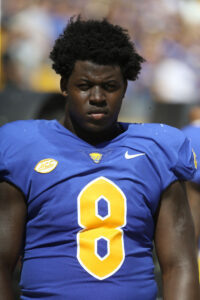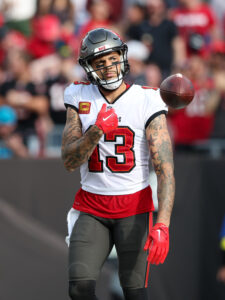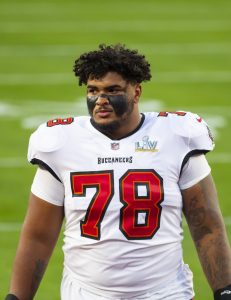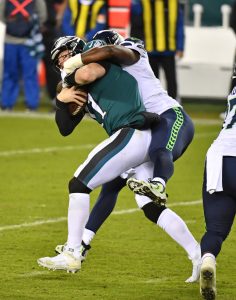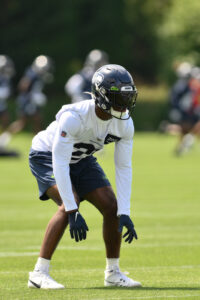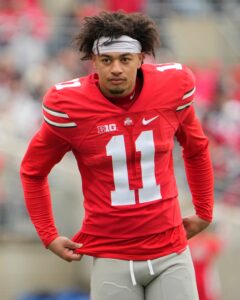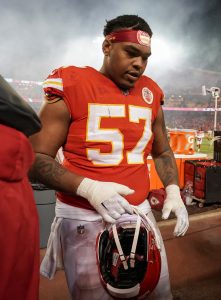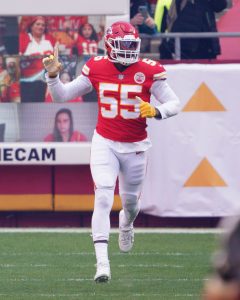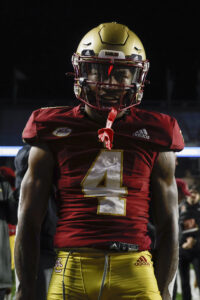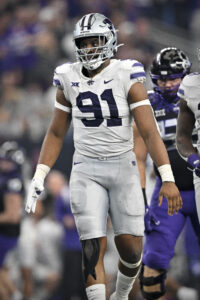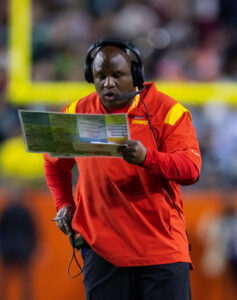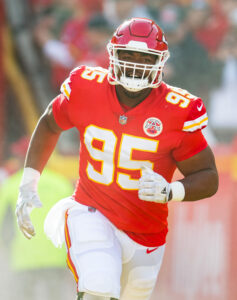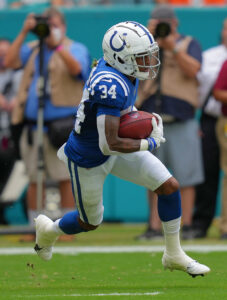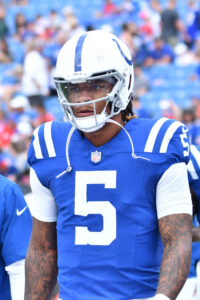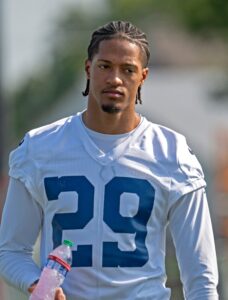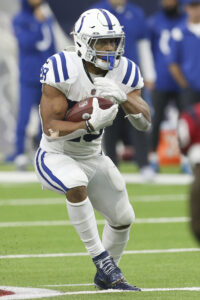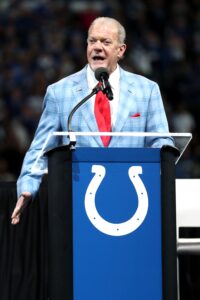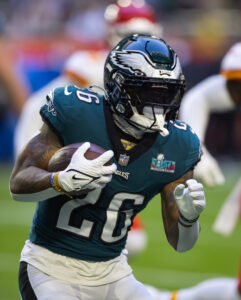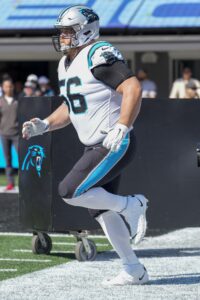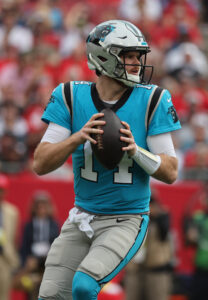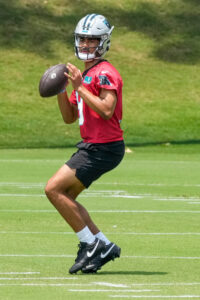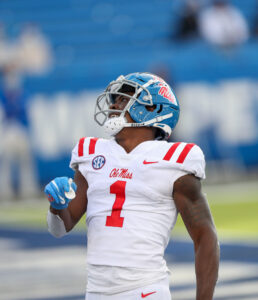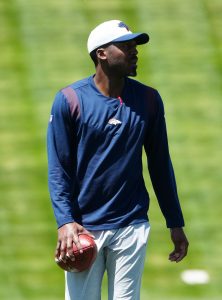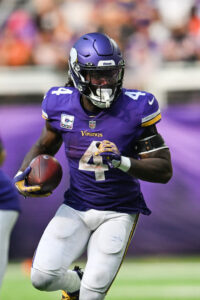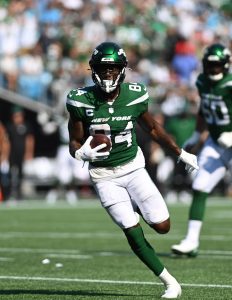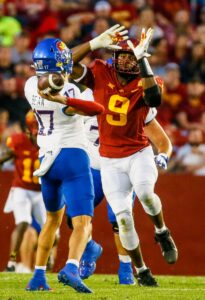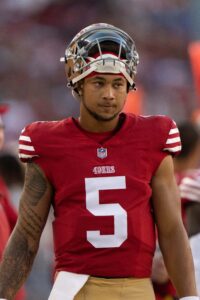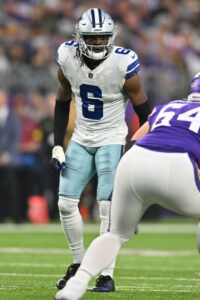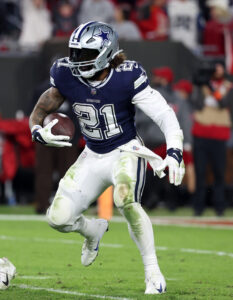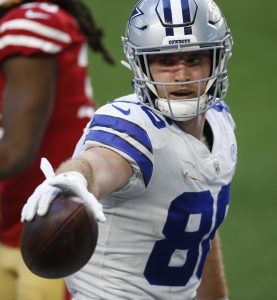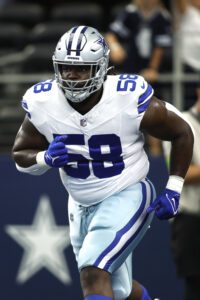Quarterback acquisitions generated top headlines this offseason, while the slew of developments affecting the running back market moved that position’s value to a precarious point. On that note, our latest Offseason In Review series is in the books. Here are the PFR staff’s looks at how teams assembled their 2023 rosters:
Following a busy offseason in 2022, the Dolphins didn’t take nearly as many swings in 2023.
It’s hard to blame them. The front office didn’t have to make up for any mistakes from last spring, as the team’s major acquisitions (receiver Tyreek Hill and offensive tackle Terron Armstead) both proved to be worth the investment. The organization also seemed to make the right decision in Mike McDaniel, as the head coach helped guide the Dolphins to their first playoff appearance since the 2016 season.
The Dolphins are clearly hoping that they can take another step forward during McDaniel’s second season at the helm. Of course, much of the team’s success will depend on the health of Tua Tagovailoa, but the team made enough offseason moves to remain in the playoff conversation heading into the 2023 campaign.
Trades:
- Acquired CB Jalen Ramsey from the Rams for a third-round pick and tight end Hunter Long
- Traded CB Noah Igbinoghene to the Cowboys for CB Kelvin Joseph
- Traded OL Dan Feeney to the Bears for a sixth-round pick
For the second-straight offseason, the Dolphins made their biggest splash via trade, as they acquired one of the league’s top cornerbacks. Jalen Ramsey was more than productive during his three-plus seasons with the Rams, earning Pro Bowl nods each season while also being named to a pair of first-team All-Pro squads.
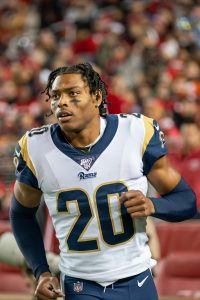 He didn’t earn the same accolades in 2022, but it was still a standout season for the veteran. Ramsey didn’t miss a game for the first time since 2018 while establishing career highs in tackles (88), passes defended (18), and interceptions (four). The 28-year-old ended up grading out as Pro Football Focus’ third-overall cornerback (among 118 qualifiers), and he paced the position with his run defense score.
He didn’t earn the same accolades in 2022, but it was still a standout season for the veteran. Ramsey didn’t miss a game for the first time since 2018 while establishing career highs in tackles (88), passes defended (18), and interceptions (four). The 28-year-old ended up grading out as Pro Football Focus’ third-overall cornerback (among 118 qualifiers), and he paced the position with his run defense score.
The Dolphins clearly identified cornerback as a need heading into the offseason. Miami’s defense struggled in 2022, particularly against the pass. Miami ranked 27th in passing yards allowed per game and 29th in interceptions. The Dolphins’ need was only magnified when it was revealed that Byron Jones was unlikely to play again, leading to his release.
Unfortunately for the Dolphins, the team won’t immediately get to see their new acquisition on the field. Ramsey suffered a torn meniscus during training camp, keeping him on the sideline for the first few months of the season. There was initial hope that Ramsey could be ready for the season opener, but his placement on injured reserve assures that he won’t see the field until Week 5 at the earliest.
Elsewhere on the trade front, the Dolphins swapped cornerbacks with the Cowboys before the roster deadline. The team gave up on former first-round pick Noah Igbinoghene, who appeared in 32 games for the Dolphins across three seasons. In exchange, they received Kelvin Joseph, a former second-rounder who played the majority of his snaps on special teams over the past two seasons in Dallas.
The Dolphins added Dan Feeney to their offensive line mix during the offseason, guaranteeing $3.13MM of his salary in the process. The veteran was ultimately squeezed off the roster, but the front office managed to find a taker in the Bears vs. cutting him for nothing.
Free agency additions:
- Eli Apple, CB: One year, $1.41MM ($500K guaranteed)
- Jake Bailey, P: One year, $1.23MM ($1.09MM guaranteed)
- Braxton Berrios, WR: One year, $3.5MM ($1.5MM guaranteed)
- DeShon Elliott, S: One year, $1.77MM ($1.08MM guaranteed)
- Tyler Kroft, TE: One year, $1.29MM ($1.16MM guaranteed)
- David Long, LB: Two years, $11MM ($6.5MM guaranteed)
- Mike White, QB: Two years, $8MM ($4.5MM guaranteed)
- Isaiah Wynn, OT: One year, $2.3MM ($1.96MM guaranteed)
Miami used free agency to fill some key backup spots on their roster. The team’s biggest acquisition was linebacker David Long, who was added to the linebackers room following four seasons with the Titans. The former sixth-round pick saw a larger role during each of his four seasons in Tennessee, culminating in a 2022 campaign where he compiled a career-high 86 tackles. 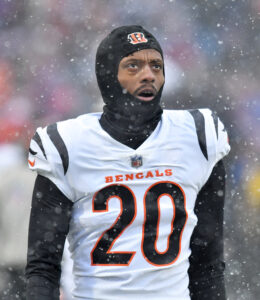 Long has missed time in each of his four NFL seasons, but as long as he’s healthy, he’s expected to start at inside linebacker next to Jerome Baker.
Long has missed time in each of his four NFL seasons, but as long as he’s healthy, he’s expected to start at inside linebacker next to Jerome Baker.
Eli Apple was added as a depth piece while the Dolphins looked to rework their cornerback corps, but he’ll likely see a significant role with Jalen Ramsey sidelined to start the season. Fortunately, Apple brings plenty of starting experience, as the veteran has started 78 of his 88 appearances. The 28-year-old spent the past two seasons in Cincinnati, collecting 98 tackles and two interceptions in 31 games.
DeShon Elliott also brings some starting experience to Miami’s secondary, with the former sixth-round pick having 35 starts on his resume. After spending the first three seasons of his career with the Ravens, Elliott spent the 2022 season in Detroit, where the safety chipped in 96 tackles and one interception. He’ll likely be the top backup to safeties Brandon Jones and Jevon Holland.
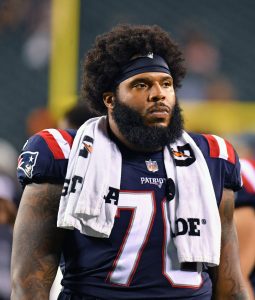 On the offensive side of the ball, the team made their biggest addition on the offensive line. Isaiah Wynn was once a first-round pick by the Patriots, but he fell out of favor in New England. Following a 2022 season where he was limited to only nine games (seven starts), the lineman hit free agency with little fanfare. He eventually got a one-year contract from Miami, where he’ll provide an upside option on the offensive line. While Wynn only ranked 72nd among 81 qualifying OTs in 2022 (per Pro Football Focus), he graded as an above-average option in each of his first three seasons in the NFL, including a 2020 campaign where he ranked 11th at his position.
On the offensive side of the ball, the team made their biggest addition on the offensive line. Isaiah Wynn was once a first-round pick by the Patriots, but he fell out of favor in New England. Following a 2022 season where he was limited to only nine games (seven starts), the lineman hit free agency with little fanfare. He eventually got a one-year contract from Miami, where he’ll provide an upside option on the offensive line. While Wynn only ranked 72nd among 81 qualifying OTs in 2022 (per Pro Football Focus), he graded as an above-average option in each of his first three seasons in the NFL, including a 2020 campaign where he ranked 11th at his position.
The rest of the team’s offensive additions are destined for backup roles. Mike White showed a little something while serving as the Jets backup/occasional starter over the past two seasons, and he’ll now be the team’s top insurance if (or when) Tua Tagovailoa is sidelined. Tyler Kroft projects as more of a backup/blocking tight end, but he’ll help soak up some of the snaps that were lost when Mike Gesicki left for the Patriots. Braxton Berrios only missed one game for the Jets over the past four seasons, and he’ll likely see a role as a key returner and as a WR option behind Tyreek Hill and Jaylen Waddle.
The 49ers have managed to field top-flight rosters — outside of the quarterback position — over the past two seasons. That talent, along with Kyle Shanahan‘s play-calling acumen, powered San Francisco to consecutive NFC championship games. Neither going the 49ers’ way applies some pressure for the otherwise well-built team to come up with a viable quarterback solution. For the time being, that is Brock Purdy, who has recovered from UCL surgery.
Undoubtedly affected by the Trey Lance miss, the 49ers have used Purdy as a partial makeup call. Will the 2022 Mr. Irrelevant’s form last? If not, the 49ers have Sam Darnold as a new option. Either Purdy or Darnold would step into an offense housing four first-team All-Pros, and with Javon Hargrave in the fold, the 49ers are prepared to throw a better defensive front at opponents this season. Will this be the year Shanahan’s bunch takes the final step and wins the organization’s sixth title?
Extensions and restructures:
- Agreed to five-year, $170MM extension with DE Nick Bosa
- Restructured TE George Kittle, LT Trent Williams‘ contracts, creating $23MM in cap space
- Restructured LB Fred Warner‘s deal, creating nearly $9MM in cap space
- Reworked RB Christian McCaffrey‘s contract, creating $8.58MM in cap space
Days before Week 1, contingency plans were in place in the event the Bosa contract was not finalized. Fortunately for the 49ers, they will have the reigning Defensive Player of the Year in uniform Sunday. Holdout is technically the correct term to use, but Bosa’s effort differed from those waged by Chris Jones and Zack Martin. With the 49ers having worked on this contract for weeks and having planned it for over a year, they surely expected Bosa to either hold in or hold out. That differs from the Martin and Jones holdouts, somewhat contentious in nature. With the 49ers allowed to waive Bosa’s fines due to this being a rookie-contract holdout, Bosa’s absence barely qualifies as a speedbump. And, like Martin, the holdout benefited Bosa.
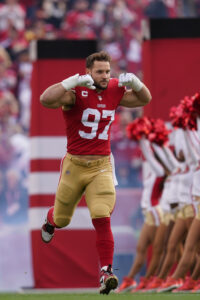 The question throughout this holdout centered around how much longer Aaron Donald‘s $31.7MM-per-year contract — one the Chiefs have attempted to treat as an outlier — would reside atop the defensive salary pecking order. Donald used a retirement threat and generational dominance to secure those terms without any new years added to his deal. Six years younger than Donald, Bosa used his importance to a loaded 49ers team — but one that depends on its top player to stay on the Super Bowl-contending level — to secure a true market reset.
The question throughout this holdout centered around how much longer Aaron Donald‘s $31.7MM-per-year contract — one the Chiefs have attempted to treat as an outlier — would reside atop the defensive salary pecking order. Donald used a retirement threat and generational dominance to secure those terms without any new years added to his deal. Six years younger than Donald, Bosa used his importance to a loaded 49ers team — but one that depends on its top player to stay on the Super Bowl-contending level — to secure a true market reset.
T.J. Watt‘s $28MM-AAV deal topped the edge defender market for two years, and the Steelers OLB locked down his game-changing second contract three days before the 2021 season. Bosa nearly matched that, accepting the 49ers’ offer four days before his team’s Week 1 trip to Pittsburgh. Watt’s contract only topped Joey Bosa‘s AAV by $1MM, making the 49ers’ Nick Bosa re-up’s result an eye-popping conclusion.
The guarantee-at-signing figure is not yet in place, and the number through three years will need to be measured as well to fully evaluate this contract. The 49ers also made Trent Williams the highest-paid tackle by inflating the AAV with a lofty final-year number. On the surface, however, Nick Bosa’s contract reshapes the edge rusher market. The $122.5MM total guarantee amount checks in more than $20MM north of Joey Bosa’s previous defender record.
This contract may create some difficulties for the Chiefs and Jones to cross the finish line, as it weakens Kansas City’s effort to classify Donald’s contract as an outlier, and cause trouble for the Cowboys and Micah Parsons down the road. Nick Bosa has more than demonstrated his value in San Francisco. Along with Jimmy Garoppolo‘s return to health, Bosa’s 2019 arrival catalyzed the 49ers’ transformation from 4-12 team to Super Bowl LIV entrant. Bosa sat out much of his final Ohio State season, readying for the NFL, and ended up in San Francisco largely because of Garoppolo’s injury ruining the 2018 team’s season.
The rare third-generation NFLer, Bosa put himself back on track for this contract by returning from a September 2020 ACL tear to play all 20 49ers games in 2021. Bosa led the league in tackles for loss that year and posted a career-high 18.5 sacks last season. His 48 QB hits in 2022 broke up a J.J. Watt sweep atop that list. While the recently retired superstar still holds four of the top five figures since QB hits became charted, Bosa’s 48 hits now sit third on that list. The 49ers will bet on the younger of this generation’s NFL Bosas anchoring their defense for the long haul.
Free agency additions:
- Javon Hargrave, DT: Four years, $81MM ($40MM guaranteed)
- Sam Darnold, QB: One year, $4.5MM ($3.5MM guaranteed)
- Isaiah Oliver, CB: Two years, $6.75MM ($2.91MM guaranteed)
- Jon Feliciano, OL: One year, $2.25MM ($2.25MM guaranteed)
- Clelin Ferrell, DE: One year, $2.5MM ($1.24MM guaranteed)
- Brandon Allen, QB: One year, $1.23MM ($200K guaranteed)
- Matt Pryor, OL: One year, $1.3MM
Among San Francisco’s signings, Hargrave’s contract obviously jumps out. Not long after Garoppolo’s contract came off their books, the 49ers sprang into action and allocated that cash to strengthen a strength. After the Bosa signing, the 49ers now have three defensive linemen making more than $17MM per year. The 49ers’ decision to trade DeForest Buckner, extend Arik Armstead and replace Buckner with Javon Kinlaw backfired. But they faced an either/or proposition with Buckner and Armstead at the time. Hargrave comes in as a fearsome hired gun, an arrangement made possible by Purdy’s seventh-round rookie contract.
 The Eagles rolled out an embarrassment of riches on their D-line last season, threatening the 1984 Bears’ sack record. While Philadelphia (70 sacks) fell two short of the 46 defense’s longstanding mark, the team produced four double-digit sack totals. Hargrave was among those, tallying a career-high 11 sacks. This is a big commitment for a D-tackle going into his age-30 season, but Hargrave used his Eagles contract to confirm he is among the league’s best inside rushers. After toiling as an unearthed gem of sorts alongside Cameron Heyward and Stephon Tuitt in Pittsburgh, Hargrave broke through in Philly.
The Eagles rolled out an embarrassment of riches on their D-line last season, threatening the 1984 Bears’ sack record. While Philadelphia (70 sacks) fell two short of the 46 defense’s longstanding mark, the team produced four double-digit sack totals. Hargrave was among those, tallying a career-high 11 sacks. This is a big commitment for a D-tackle going into his age-30 season, but Hargrave used his Eagles contract to confirm he is among the league’s best inside rushers. After toiling as an unearthed gem of sorts alongside Cameron Heyward and Stephon Tuitt in Pittsburgh, Hargrave broke through in Philly.
Buckner and Bosa only overlapped for one season, which happened to produce a Super Bowl berth, so it will be interesting to see what well-regarded D-line coach Kris Kocurek can do with a Bosa-Armstead-Hargrave troika. Missing only three games in seven seasons, Hargrave also offers durability the 49ers have lacked from Armstead and Kinlaw. This certainly looks like the 49ers’ best defensive line since that 2019 unit.
Kocurek reviving Ferrell’s career would further highlight his potential for a defensive coordinator post. The Raiders surprised most by taking Ferrell fourth overall in 2019, but the Mike Mayock–Jon Gruden pick did not live up to his draft slot. During his final two years with the Raiders, the Clemson product had drifted to the backup level. Ferrell totaled just 5.5 sacks over the past three seasons, lowering his price in free agency. Had Bosa extended his holdout past Week 1, however, Ferrell was in place to start alongside 2022 second-rounder Drake Jackson. The fifth-year edge rusher looms as a wild card in Steve Wilks‘ defense.
The 49ers targeted Oliver as a nickel who could match up with bigger slot receivers, following Jimmie Ward in that regard. The Falcons moved Oliver inside later in his run with the team, and Pro Football Focus rated him as a top-10 corner last year. That said, the 210-pound cover man did not impress in the preseason. It will be interesting to see if he can stick as the slot option for the 49ers, who have Charvarius Ward and Deommodore Lenoir camped on the boundaries.
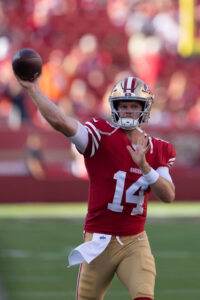 Shanahan has shown tremendous confidence in Purdy, who completed his rehab and shed limitations earlier than expected. But Darnold came into the NFL undeniably more talented. And the former No. 3 overall pick impressed during his first offseason in San Francisco. Shanahan has spoken highly of the former Jets and Panthers starter, and while Darnold has enjoyed plenty of opportunities to showcase his skill (55 starts), it is difficult to compare his New York and Charlotte setups to Shanahan’s infrastructure. Darnold, 26, joined the 49ers largely because of Shanahan and their array of skill-position talent.
Shanahan has shown tremendous confidence in Purdy, who completed his rehab and shed limitations earlier than expected. But Darnold came into the NFL undeniably more talented. And the former No. 3 overall pick impressed during his first offseason in San Francisco. Shanahan has spoken highly of the former Jets and Panthers starter, and while Darnold has enjoyed plenty of opportunities to showcase his skill (55 starts), it is difficult to compare his New York and Charlotte setups to Shanahan’s infrastructure. Darnold, 26, joined the 49ers largely because of Shanahan and their array of skill-position talent.
Darnold has also shown himself to be an unremarkable pro QB through five seasons, and he has battled availability issues in each of his seasons. But it did not seem to be much of a contest between he and Trey Lance for the 49ers’ backup job, even as Lance carried experience in Shanahan’s system. Darnold QB2 buzz circulated in the spring and intensified before camp.
The 49ers had targeted a veteran QB due mostly to Purdy and Lance’s injury issues, but Darnold has the pedigree to potentially challenge Purdy, should the former Iowa State starter struggle coming off elbow surgery. Brutal QB injury fortune has hounded the Shanahan-era 49ers. While Darnold is only tied to a $4.5MM salary, he could become an important figure in the NFC’s Super Bowl chase.
Re-signings:
- Jake Brendel, C: Four years, $16.5MM ($5MM guaranteed)
- Tashaun Gipson, S: One year, $2.9MM ($2.17MM guaranteed)
- Kevin Givens, DT: One year, $2MM ($2MM guaranteed)
- Colton McKivitz, T: Two years, $4.56MM ($1.87MM guaranteed)
- Taybor Pepper, LS: Three years, $3.96MM ($1.5MM guaranteed)
- Ross Dwelley, TE: One year, $1.7MM ($700K guaranteed)
- Kerry Hyder, DE: One year, $1.1MM
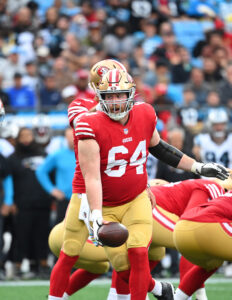 Center retention was not particularly costly around the league this offseason. Five teams — the 49ers, Browns, Jets, Panthers and Vikings — preferred continuity over installing an outsider at the pivot. The Brendel, Ethan Pocic, Connor McGovern, Bradley Bozeman and Garrett Bradbury deals all came in at less than $6MM. For Brendel, that represented a reward for capitalizing on a surprising opportunity.
Center retention was not particularly costly around the league this offseason. Five teams — the 49ers, Browns, Jets, Panthers and Vikings — preferred continuity over installing an outsider at the pivot. The Brendel, Ethan Pocic, Connor McGovern, Bradley Bozeman and Garrett Bradbury deals all came in at less than $6MM. For Brendel, that represented a reward for capitalizing on a surprising opportunity.
The 49ers brought in ex-Shanahan Falcons cog Alex Mack for what turned out to be a one-off in 2021, installing him over Brendel. Rather than chase a veteran last year, the team promoted Brendel, who came into the season with 250 offensive snaps in six seasons. The confidence paid off for the 49ers, who received 20 total starts from Brendel. The former UDFA, who will turn 31 on Sunday, graded fifth in ESPN’s run block win rate metric during his starter audition.
Overall, the 49ers should be better positioned on their interior O-line due to the experience first-time starters Brendel, Aaron Banks and Spencer Burford gained last season. Feliciano, who shifted back to guard this offseason, started for the Giants at center throughout last season. He makes for a nice swing backup and potential Burford platoon partner. But right tackle does present a question.
Sticking with their all-in approach around Tom Brady a year too long, the Buccaneers still benefited considerably from their 2020 free agency coup. The franchise added a second Super Bowl title and saw Brady display better form in 2021. Brady’s unretirement helped the Bucs stay atop the NFC South, but it took a historically terrible division for that to happen. The Bruce Arians-to-Todd Bowles transition did not go well, and the latter’s seat may already be warm.
The Bucs’ round of early-2020s restructures — Brady’s chief among them — led to cap trouble this year and did not allow for the team to make splashy outside upgrades. As a result, the Bucs are not receiving much attention going into their first post-Brady season.
Free agency additions:
- Baker Mayfield, QB: One year, $4MM ($4MM guaranteed)
- Greg Gaines, DT: One year, $3.5MM ($3.5MM guaranteed)
- Matt Feiler, G: One year, $2.5MM ($1.29MM guaranteed)
- Ryan Neal, S: One year, $1.23MM ($1.1MM guaranteed)
- Chase Edmonds, RB: One year, $1.23MM ($153K guaranteed)
- Chase McLaughlin, K: One year, $1.13MM ($100K guaranteed)
Mayfield will soon take snaps for a fourth team in barely 20 months. The Ravens also discussed terms with Mayfield, though those talks were framed around the former No. 1 overall pick becoming a QB2 upgrade. The Bucs carried an obvious quarterback need following Brady’s second retirement, but the $35.1MM void-years bill kept the team out of the Derek Carr and Jimmy Garoppolo markets. While the Bucs also considered Jacoby Brissett, he ended up with the Commanders for twice the money Mayfield scored. With the Bucs mandating a low-cost veteran, the former No. 1 overall pick has what likely profiles as a last chance to prove himself as a starter.
 With the exception of rookie-contract players, Mayfield’s $4MM AAV is miles below every other Week 1 QB. The $4MM base value make it more in line with the backup tier, and many QB2 options — Brissett, Andy Dalton, Taylor Heinicke, Marcus Mariota, Jarrett Stidham — landed more than the player who was in talks with the Browns about a lucrative extension in 2021.
With the exception of rookie-contract players, Mayfield’s $4MM AAV is miles below every other Week 1 QB. The $4MM base value make it more in line with the backup tier, and many QB2 options — Brissett, Andy Dalton, Taylor Heinicke, Marcus Mariota, Jarrett Stidham — landed more than the player who was in talks with the Browns about a lucrative extension in 2021.
It is difficult to overstate the tumble Mayfield’s stock has taken since he was at the heart of the Browns snapping a 17-season playoff drought. A shoulder injury keyed a 2021 dip, but Mayfield did not bounce back in Carolina. Instead, his Panthers tenure ended with the team waiving him — as he sat dead last in QBR — despite having clawed back into the dreadful NFC South race. Illustrating how bad Mayfield was in Carolina, his memorable Los Angeles stay — which included the two-days-notice 98-yard game-winning drive to stun the Raiders — did not pull him out of last place. Mayfield played well against the Broncos on Christmas Day but still finished miles behind the second-worst signal-caller in 2022 QBR.
Bucs were willing to take what amounted to a flier on the 2017 Heisman winner, and instead of drafting another passer, they only pitted two-year third-stringer Kyle Trask against Mayfield. It took all three preseason games for Mayfield to beat out the 2021 second-rounder. Mayfield finished the 2020 season with 26 touchdown passes, eight interceptions and a 10th-place QBR finish. That represents his most recent healthy season, one that powered Kevin Stefanski to Coach of the Year honors and involved the Browns embarrassing the Steelers in Round 1 despite Stefanski home with COVID-19.
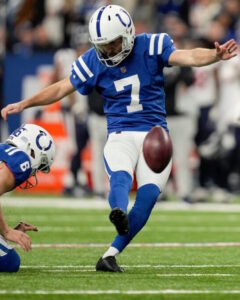 The Bucs will hope a stable Mayfield offseason leads to this form resurfacing, but while Tampa Bay may have that Cleveland team outflanked for receiver talent, an elite Browns O-line aided the 6-foot-1 QB that year. New Tampa Bay OC Dave Canales coaching under ex-Sean McVay assistant Shane Waldon in Seattle stands to help Mayfield, who is going into his age-28 season. But it will certainly not surprise to see Trask receive an extended look. Barring a Mayfield turnaround few expect, the Bucs look likely to enter the 2024 offseason with a dire QB need.
The Bucs will hope a stable Mayfield offseason leads to this form resurfacing, but while Tampa Bay may have that Cleveland team outflanked for receiver talent, an elite Browns O-line aided the 6-foot-1 QB that year. New Tampa Bay OC Dave Canales coaching under ex-Sean McVay assistant Shane Waldon in Seattle stands to help Mayfield, who is going into his age-28 season. But it will certainly not surprise to see Trask receive an extended look. Barring a Mayfield turnaround few expect, the Bucs look likely to enter the 2024 offseason with a dire QB need.
For the second time in four years, McLaughlin and Rodrigo Blankenship battled for a kicker job. After Blankenship beat out McLaughlin to succeed Adam Vinatieri in Indianapolis in 2020, the latter won the relocated rematch. While McLaughlin has enjoyed some extended work — in being a full-time option in Cleveland and Indianapolis over the past two years — the Bucs will be the 2019 UDFA’s seventh NFL team.
Both Feiler and Gaines served as multiyear starters in Los Angeles — Feiler at right guard for the Chargers, Gaines as a defensive tackle for the Rams — and their price tags aligned with the Bucs’ offseason itinerary. Purging more veterans than the Bucs did this year, the Rams let both Aaron Donald‘s recent wingmen — Gaines and A’Shawn Robinson — walk. Gaines, 27, started for the past two seasons and totaled 8.5 sacks and 19 QB hits in that span. With Calijah Kancey arriving in Round 1, it looks like Gaines will return to a bench role.
 Feiler, 31, has been a starter for the past five seasons — for the Steelers and Bolts — and Pro Football Focus rated him as a top-20 guard in 2019 and ’21. The Bucs have the former UDFA at a discount because of a down 2022, when PFF slotted him outside the top 60 at the position. Given the Bucs’ rampant injury issues up front last season, Feiler offers short-term stability. He has missed just four games over the past four years. The Feiler addition will allow the Bucs to move 2022 second-rounder Luke Goedeke to right tackle, his primary college position.
Feiler, 31, has been a starter for the past five seasons — for the Steelers and Bolts — and Pro Football Focus rated him as a top-20 guard in 2019 and ’21. The Bucs have the former UDFA at a discount because of a down 2022, when PFF slotted him outside the top 60 at the position. Given the Bucs’ rampant injury issues up front last season, Feiler offers short-term stability. He has missed just four games over the past four years. The Feiler addition will allow the Bucs to move 2022 second-rounder Luke Goedeke to right tackle, his primary college position.
Edmonds joins Mayfield in coming off a rough 2022. After his Cardinals work led to a two-year, $12MM Dolphins pact, Edmonds proved a poor fit in Mike McDaniel‘s offense. The Dolphins included the underwhelming satellite back as salary filler in the Bradley Chubb trade. The Broncos then cut him in March. In a bad year to be a free agent running back, Edmonds did score another opportunity and will slide in as the team’s passing-down back complementing Rachaad White. Edmonds, 27, did excel in a similar role alongside Kenyan Drake in 2020 but saw James Conner‘s re-emergence overshadow him the following year.
Re-signings:
- Jamel Dean, CB: Four years, $52MM ($21.5MM guaranteed)
- Anthony Nelson, OLB: Two years, $10MM ($5.5MM guaranteed)
- Lavonte David, ILB: One year, $4.5MM ($4.5MM guaranteed)
- William Gholston, DL: One year, $2.67MM ($1.32MM guaranteed)
- Aaron Stinnie, OL: One year, $1.4MM
- Nick Leverett, OL: One year, $940K
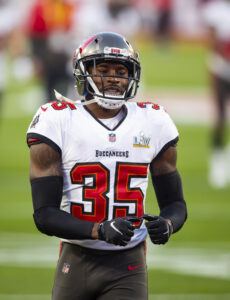 In Saints-like fashion, the Bucs managed to move from $55MM-plus over the cap upon Brady’s February 1 retirement to a place where they could make a viable offer to retain Dean. The Bucs followed their Carlton Davis blueprint with Dean. A year after they let Davis test free agency and then signed him to a three-year, $44.5MM deal, the Bucs reeled Dean back in early during the legal tampering period. Neither Davis nor Dean landed top-10 cornerback money, but both contract sit in the top 15 among AAV at the position.
In Saints-like fashion, the Bucs managed to move from $55MM-plus over the cap upon Brady’s February 1 retirement to a place where they could make a viable offer to retain Dean. The Bucs followed their Carlton Davis blueprint with Dean. A year after they let Davis test free agency and then signed him to a three-year, $44.5MM deal, the Bucs reeled Dean back in early during the legal tampering period. Neither Davis nor Dean landed top-10 cornerback money, but both contract sit in the top 15 among AAV at the position.
Excelling in press coverage, Dean played a major role for the 2020 Super Bowl champion Bucs iteration and overtook Sean Murphy-Bunting last season. Dean did perform better in 2021 compared to 2022, allowing no touchdowns and limiting QBs to a collective 50.0 passer rating; those numbers shot up to four and 86.0 last season. But Dean also played more snaps last year, going from 685 in 2021 to 885. PFF rated Dean as last season’s 10th-best corner, and the former third-round pick will stay with the team that drafted him.
 One of the best players in franchise history, David is back with the Bucs on a fourth contract. For a bit, it looked like the linebacker stalwart would leave Tampa after 11 seasons. David, 33, signed a lucrative five-year deal in 2015 and then, as the Bucs completed a historic talent-retention effort to retain the entire core of their Super Bowl LV-winning team, reupped on a two-year deal in 2021. This contract will bring a pay reduction for one of this era’s best off-ball linebackers, but as the Bucs transition to their post-Brady period, keeping David and Dean ensures continuity from their Super Bowl squad.
One of the best players in franchise history, David is back with the Bucs on a fourth contract. For a bit, it looked like the linebacker stalwart would leave Tampa after 11 seasons. David, 33, signed a lucrative five-year deal in 2015 and then, as the Bucs completed a historic talent-retention effort to retain the entire core of their Super Bowl LV-winning team, reupped on a two-year deal in 2021. This contract will bring a pay reduction for one of this era’s best off-ball linebackers, but as the Bucs transition to their post-Brady period, keeping David and Dean ensures continuity from their Super Bowl squad.
The former second-round pick totaled 124 tackles last season and has 10-plus TFLs in four of the past five seasons. David’s three sacks last season quietly ran his total to 29 over the course of his career. With Devin White generating criticism for inconsistency, the Bucs have continued to rely on David. The Nebraska product has seen his consistency pay off. After the Bucs ended a playoff drought that had covered David’s first eight seasons, he became a vital piece for two strong teams to start the 2020s.
Shaq Barrett‘s return from a midseason Achilles tear should move Nelson back to a rotational role — behind Barrett and Joe Tryon-Shoyinka — but the former fourth-round pick does have 10.5 sacks over the past two seasons. Barrett coming back will give the Bucs an interesting two-deep at outside linebacker, with third-rounder Yaya Diaby joining Nelson, who forced three fumbles last season as the Bucs attempted to get by without their top sack artist.
Notable losses:
- Genard Avery, LB
- Giovani Bernard (retired)
- Tom Brady, QB (retired)
- Cameron Brate, TE (released)
- Mike Edwards, S
- Leonard Fournette, RB (released)
- Blaine Gabbert, QB
- Akiem Hicks, DL
- Julio Jones, WR
- Scotty Miller, WR
- Sean Murphy-Bunting, CB
- Carl Nassib, OLB
- Keanu Neal, S
- Rakeem Nunez-Roches
- Breshad Perriman, WR
- Kyle Rudolph, TE (retired)
- Logan Ryan, S
- Donovan Smith, LT (released)
- Ryan Succop, K (released)
- Josh Wells, OL
Brady’s Bucs period added a key separation between he and Bill Belichick‘s legacies, and while the tenure did not necessarily end well, the QB icon reaching seven Super Bowl titles and ending a 12-year Tampa Bay playoff drought classifies the 2020 signing as an undisputed win for the franchise. Brady’s preposterously long prime lasted through the 2021 season, and although he showed flashes (in the form of some wild comebacks) as the 2022 Bucs broke down, the unretirement year brought clear decline signs. Brady used last season to fulfill his longtime goal of playing through age 45, and that feat allowed him to become the only regular QB to go through a season at that age.
Life after Russell Wilson began for the Seahawks in 2022, a season in which very little was expected of the team. Rather than setting upon a long-term organizational reset, however, Seattle remained competitive in large part due to the surprising success Geno Smith found in his latest opportunity to serve as an NFL starter. The veteran steered the team to a playoff berth, and the young contributors added in each of the past two drafts offer considerable reasons for optimism moving forward.
Weaknesses on defense were exposed throughout the season, though, and much of the team’s efforts in recent months (including a reunion with an icon from Seattle’s Super Bowl-winning core) has been aimed at addressing them. If they prove to have been successful, Smith – the reigning Comeback Player of the Year who has a new, more lucrative Seahawks deal in place – will be well-positioned to prove 2022’s success was not a fluke.
Free agency additions:
- Dre’Mont Jones, DT: Three years, $51.53MM ($23MM guaranteed)
- Julian Love, S: Two years, $12MM ($5.98MM guaranteed)
- Bobby Wagner, LB: One year, $5.5MM ($4.48MM guaranteed)
- Jarran Reed, DT: Two years, $9MM (4.19MM guaranteed)
- Devin Bush, LB: One year, $3.5MM ($2.99MM guaranteed)
- Evan Brown, C: One year, $2.25MM ($1MM guaranteed)
- Mario Edwards, DE: One year, $1.32MM ($153K guaranteed)
- Austin Faoliu, DL: One year, $750K
Seattle ranked 30th against the run in 2022, and breakdowns in the front seven were common during the regular season. That factored into the team’s postseason exit as well, as the 49ers recorded over 500 yards of offense in their wild-card victory over the Seahawks. Long before free agency began, it was therefore obvious that much of the offseason would need to be devoted to reconfiguring the defensive line and linebacking corps. 
Jones will be at the heart of that effort, tasked with providing a much-needed boost with respect to interior pass-rushing production. The Seahawks finished tied for seventh in the league in sacks last year, but much of that came off the edge. If Jones can replicate his success from Denver, more balance will be attained. The 26-year-old totaled 22 sacks and 60 pressures across four years with the Broncos, making him one of the most attractive members of a deep D-line free agent class.
The Broncos were interested in retaining Jones, but for a time he seemed to be headed toward a deal with his hometown Browns. In the end, the former third-rounder landed a contract with a higher AAV than what both Denver and Cleveland gave to Zach Allen and Dalvin Tomlinson, respectively. The latter two are regarded as better run defenders than Jones, but if he remains productive on passing downs, he will be central to a rebound performance from Seattle’s defense.
Both Reed – who is returning to Seattle after spending his first five seasons there – and Edwards are in line for starting roles alongside Jones. That new trio will give the team a much different look in its second year with a 3-4 base scheme, although depth additions could be on the radar. In any event, the play of the revamped D-line will be a major storyline in 2023.
 The Seahawks already had the league’s most expensive safety tandem in Jamal Adams and Quandre Diggs before adding Love to the mix. The latter expressed a desire to remain with the Giants after his breakout season, though he was acutely aware of how his 2022 production helped his earning power. The 25-year-old will be able to hit the open market a second time rather quickly if he plays out this Seattle deal without an extension, though he could play his way into the team’s long-term plans if he picks up where he left off last season.
The Seahawks already had the league’s most expensive safety tandem in Jamal Adams and Quandre Diggs before adding Love to the mix. The latter expressed a desire to remain with the Giants after his breakout season, though he was acutely aware of how his 2022 production helped his earning power. The 25-year-old will be able to hit the open market a second time rather quickly if he plays out this Seattle deal without an extension, though he could play his way into the team’s long-term plans if he picks up where he left off last season.
Love posted career-highs in a number of categories during the 2022 campaign, his first operating as a full-time starter. He remained a constant in a Giants secondary which faced injury absences for much of the year, seeing usage at a number of different spots on the field. The Notre Dame alum thus made himself one of several noteworthy safeties who were available in free agency, although a number of players with a longer track record at the position secured more lucrative deals.
Adams’ history of missed time – which will continue into the 2023 campaign – could make Love’s presence particularly important for Seattle. Plenty of playing time should be available when the Seahawks’ starting trio are all healthy, in any case, and Love will be a central figure in the team’s play on the backend.
Wagner’s fifth career contract is far smaller than all but his rookie pact, but it will be a valuable one on several fronts if he can maintain his level of play upon his return to the Emerald City. A central figure in the Legion of Boom-era defenses throughout a 10-year Seahawks run to begin his career, the eight-time Pro Bowler’s time with the team appeared to be over when he took a five-year, $50MM contract with the division rival Rams last offseason. 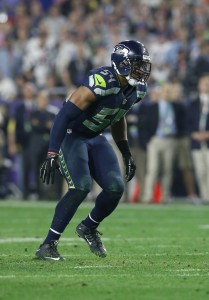
The 33-year-old drew the No. 1 PFF grade amongst inside linebackers in his debut Los Angeles season. After a calamitous title defense, however, the Rams elected to part ways with several high-priced veterans. Part of that process including granting Wagner’s release request, clearing the way for his return to Seattle, one which could result in up to $7MM in earnings. The six-time first-team All-Pro will reprise the starting role at the Seattle LB spot he has held for most of his career, and a continuation of his past performances would go a long way in stabilizing the Seahawks’ reconfigured front seven.
Bush could play a role in that regard as well, and success in a new environment would do wonders for his career. The former Steelers first-rounder flamed out in the seasons following his 2020 ACL tear, seeing his playing time drop sharply in each of the past two years. Bush, 25, will likely work in a rotational capacity behind Wagner and incumbent starter Jordyn Brooks, neither of whom are on the books for 2024. He could thus play his way into an extended stay in Seattle, or at least help his prospects in free agency next spring.
Re-signings:
- Geno Smith, QB: Three years, $75MM ($27.3MM guaranteed)
- Jason Myers, K: Four years, $21.1MM ($8.67MM guaranteed)
- Phil Haynes, G: One year, $4MM ($3.49MM guaranteed)
- Nick Bellore, LB: Two years, $6.6MM ($2.3MM guaranteed)
- Drew Lock, QB: One year, $4MM ($1.75MM guaranteed)
- Michael Jackson, CB: One year, $940K
- Cody Thompson, WR: One year, $870K
- Myles Adams, DL: One year, $870K
After the blockbuster deal sending Wilson to Denver, a QB competition which received little fanfare took place last summer. Many expected Lock, part of the package sent by the Broncos, to beat out Smith for the starting role. It was instead the latter who earned the No. 1 job, and he held it for every snap of the regular and postseason.
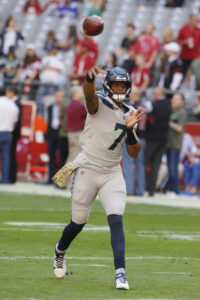 Six years removed from his last campaign as a full-time starter, Smith authored an incredibly unlikely success story in 2022. The 32-year-old led the league in completion percentage (69.8%), shattered his career high in touchdown passes (30) and finished in the top 10 of MVP voting. A considerable raise from the $3.5MM he saw in 2022 and the smaller figures represented in his previous one-year Seahawks pacts was in order.
Six years removed from his last campaign as a full-time starter, Smith authored an incredibly unlikely success story in 2022. The 32-year-old led the league in completion percentage (69.8%), shattered his career high in touchdown passes (30) and finished in the top 10 of MVP voting. A considerable raise from the $3.5MM he saw in 2022 and the smaller figures represented in his previous one-year Seahawks pacts was in order.
On the other hand, Seattle was frequently named as a team to watch with respect to drafting a passer in April. Both head coach Pete Carroll and general manager John Schneider admitted to doing more QB scouting than usual while in the rare position of having a top-five pick (owing to the Broncos’ struggles in their first season with Wilson at the helm). A long-term answer at the position will still likely be coming sooner than later. But for at least one more year the Seahawks will maintain the Smith-Lock tandem.
Should Smith’s 2022 turn out to be fluky, the Seahawks will be able to escape this contract fairly easily in 2024. The team could move on via a post-June 1 cut in either of the next two offseasons and see notable cap savings against only an $8.7MM dead cap charge. Despite his success last year, Smith will therefore face another round of considerable expectations as he looks to back up his production and lead the Seahawks to consecutive postseason berths.
Lock’s deal can reach up to $7.5MM via incentives, something which would come into play if Smith were to miss time or regress. Either scenario could put his Seattle future in jeopardy, given the fact his contract only includes full guarantees for this season.
Myers proved to be a solid investment in 2019 after his stints with the Jaguars and Jets. He has gone a combined 98-for-112 on field goals during his time in Seattle (including 13-for-17 on kicks beyond 50 yards). The 32-year-old earned a second career Pro Bowl nod in 2022 and made the decision to authorize a re-up an easy one from the team’s perspective. Meyers now sits third in the league for AAV amongst kickers ($5.28MM) behind only Justin Tucker and Matt Gay, setting himself up to continue his consistent play with the Seahawks.
As partially chronicled on Netflix, the Chiefs secured their second Super Bowl championship in four seasons. Patrick Mahomes is now 3-for-5 in Super Bowl appearances as a starter and is the first quarterback since Otto Graham (1950-55) to begin an NFL career with five straight conference championship games. The two-time MVP gutted through a high ankle sprain to lift the Chiefs past the Jaguars, Bengals and Eagles.
Trading Tyreek Hill and letting Tyrann Mathieu walk in free agency, the Chiefs probably vanquished multiple playoff foes with better overall rosters. The Eagles certainly had such a claim. But Kansas City’s Mahomes-Andy Reid foundation has provided a historic advantage, compensating for roster issues elsewhere. The Chiefs have been fortunate regarding the availability of Mahomes’ top two co-stars. Travis Kelce and Chris Jones each suiting up for all 20 games obviously aided last year’s effort. There is a good chance neither will play in Week 1, giving the Mahomes-Reid partnership a new challenge to start its latest title defense.
Free agency additions:
- Jawaan Taylor, T: Four years, $80MM ($40MM guaranteed)
- Charles Omenihu, DE: Three years, $24MM ($8.6MM guaranteed)
- Mike Edwards, S: One year, $3MM ($2.48MM guaranteed)
- Drue Tranquill, LB: One year, $3MM ($2.45MM guaranteed)
- Blaine Gabbert, QB: One year, $1.32MM ($1.1MM guaranteed)
- Donovan Smith, T: One year, $3MM ($1.98MM guaranteed)
- Richie James, WR: One year, $1.32MM ($553K guaranteed)
- Lamar Jackson, CB: One year, $940K
A trade package centering around a first-round pick brought Orlando Brown Jr. to Kansas City in 2021. The Chiefs then franchise-tagged him last year. After not re-tagging Brown, the defending champions have made some changes regarding their tackle priority. They have taken care of the right tackle spot with Taylor and brought in a veteran placeholder in Smith, whom the Buccaneers released in March. This is a rather interesting setup, as the Reid years have either featured mid- or high-level investments in both tackle spots (Eric Fisher, Mitchell Schwartz) or seen the RT position overlooked.
 For a stretch immediately following Taylor’s signing, it appeared the plan would be to move the former Jaguars and Florida Gators right tackle to the blind side. The team changed course upon signing Smith in May. Taylor, 25, will now keep going on the right side.
For a stretch immediately following Taylor’s signing, it appeared the plan would be to move the former Jaguars and Florida Gators right tackle to the blind side. The team changed course upon signing Smith in May. Taylor, 25, will now keep going on the right side.
The four-year Jags starter has never missed a game. While PFR rated Taylor third overall for free agent earning power, the Chiefs think highly of a player who needed to win a training camp battle — over Walker Little — to keep his RT job going into last season. Taylor’s contract-year work scored him a life-changing payday, and he will camp outside of Florida for the first time. The Jaguars decided on tagging Evan Engram, a cheaper option that led to an extension, over cuffing Taylor. Jacksonville already has a top-10 left tackle payment (for Cam Robinson) on its books. Taylor then joined Mike McGlinchey and Kaleb McGary in comprising a strong right tackle free agency class.
More of a pass pro-oriented right tackle compared to McGlinchey, Taylor boasts a skillset fitting Reid’s attack better. Pro Football Focus has long been skeptical of Taylor’s abilities, having not ranked him inside the top 60 among tackles since his rookie year, when the advanced metrics site slotted him 49th. However, the former second-round pick dropped his hold count from 11 in 2021 to two last season. And Football Outsiders charted Taylor as posting a career-low blown-block rate (1.3%).
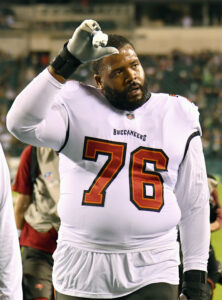 This represents a risk from the Chiefs, who gave a player who was not exactly viewed as an upper-echelon right tackle for much of his rookie-contract run the second-most lucrative contract at the position. Taylor’s $20MM AAV trails only Lane Johnson‘s ($20.2MM). A significant accolade disparity exists between those two, but the Chiefs are betting the fifth-year blocker’s best football lies ahead. Taylor will join one of the NFL’s best O-line nuclei, which still features rookie-deal cogs Creed Humphrey and Trey Smith.
This represents a risk from the Chiefs, who gave a player who was not exactly viewed as an upper-echelon right tackle for much of his rookie-contract run the second-most lucrative contract at the position. Taylor’s $20MM AAV trails only Lane Johnson‘s ($20.2MM). A significant accolade disparity exists between those two, but the Chiefs are betting the fifth-year blocker’s best football lies ahead. Taylor will join one of the NFL’s best O-line nuclei, which still features rookie-deal cogs Creed Humphrey and Trey Smith.
Older blockers now populate the left side of Kansas City’s line. Smith and left guard Joe Thuney are both 30. Smith also struggled during his final Bucs campaign, rating one spot behind Taylor (66th) in PFF’s view. His 12 penalties (including seven holds) ranked second in the NFL, and Todd Bowles considered benching the longtime left tackle last season. We slotted the Chiefs as the best Smith fit, and the ex-Tom Brady protector will be thrust into another high-profile spot. The second-longest-tenured left tackle in Bucs history, Smith signed three contracts with the team and has made 124 career starts.
A Missouri native who starred at Mizzou after Chase Daniel‘s exit from the then-Big 12 program, Gabbert is back in his home state after 12 seasons elsewhere. The Chiefs’ previous Mahomes backup, Chad Henne, once replaced Gabbert in Jacksonville in the early 2010s. That demotion — after being chosen 10th overall in 2011 — dropped Gabbert to the backup tier. Other than when he briefly unseated Colin Kaepernick in San Francisco, Gabbert has remained a backup ever since the Jags’ decision.
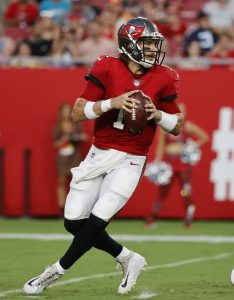 Brady did not miss a start with the Bucs, keeping Gabbert on the bench. Gabbert did make some successful cameos under Bruce Arians with the 2017 Cardinals; his last starts came with the 2018 Titans. Mahomes displayed his toughness during the playoffs but has missed time in two of Kansas City’s past three divisional-round games. Mahomes also missed two games in 2019 with a knee injury. Henne and Matt Moore made memorable contributions to help Super Bowl-winning Chiefs squads. Reid pulling Moore out of retirement in 2019, after a season-ending Henne injury, and coaxing decent performances bodes well for Gabbert’s potential form should Mahomes go down.
Brady did not miss a start with the Bucs, keeping Gabbert on the bench. Gabbert did make some successful cameos under Bruce Arians with the 2017 Cardinals; his last starts came with the 2018 Titans. Mahomes displayed his toughness during the playoffs but has missed time in two of Kansas City’s past three divisional-round games. Mahomes also missed two games in 2019 with a knee injury. Henne and Matt Moore made memorable contributions to help Super Bowl-winning Chiefs squads. Reid pulling Moore out of retirement in 2019, after a season-ending Henne injury, and coaxing decent performances bodes well for Gabbert’s potential form should Mahomes go down.
The Reid-era Chiefs have not shown much concern for adding players deemed character risks. One of those gambles (Hill) will be in the Hall of Fame one day; another (Frank Clark) made vital postseason contributions. This has created some controversy, but the Chiefs have also generated some positive results from this old-school strategy. The Chiefs, who also gave ex-first-round cornerbacks DeAndre Baker and Damon Arnette second chances after off-field issues led to early exits elsewhere, will bet on Omenihu. The former Nick Bosa supporting-caster was arrested on a domestic violence charge in January. He already received a six-game suspension.
 Omenihu, 26, showed promising form for a 49ers team that frequently enhances defensive ends’ capabilities, posting the 12th-best pass rush win rate — among D-ends — in 2021 and totaling 4.5 sacks and 16 QB hits last year. With the Chiefs cutting Clark and depending on two recent first-rounders (George Karlaftis, Felix Anudike-Uzomah) on the edge, Omenihu stands to become an important piece. This suspension threatens to void the fifth-year pass rusher’s guarantees; it will also place pressure on the two young DEs as Jones remains on the reserve/did not report list.
Omenihu, 26, showed promising form for a 49ers team that frequently enhances defensive ends’ capabilities, posting the 12th-best pass rush win rate — among D-ends — in 2021 and totaling 4.5 sacks and 16 QB hits last year. With the Chiefs cutting Clark and depending on two recent first-rounders (George Karlaftis, Felix Anudike-Uzomah) on the edge, Omenihu stands to become an important piece. This suspension threatens to void the fifth-year pass rusher’s guarantees; it will also place pressure on the two young DEs as Jones remains on the reserve/did not report list.
Even with the off-ball linebacker market featuring few major paydays this offseason, Tranquill’s low-cost pact surprised. The former fourth-round pick out of Notre Dame was one of the NFL’s most productive linebackers last season, pairing 146 tackles with five sacks, four pass deflections and a forced fumble. The Chargers let the Gus Bradley-era investment Tranquill walk and gave Eric Kendricks a two-year, $13.25MM deal. Reid reaching out to Tranquill, 28, helped seal the deal for the fifth-year linebacker to join Nick Bolton and Willie Gay on Kansas City’s defensive second level.
Re-signings:
- Justin Watson, WR: Two years, $3.4MM ($1.3MM guaranteed)
- Jerick McKinnon, RB: One year, $1.32MM ($1.1MM guaranteed)
- Derrick Nnadi, DT: One year, $1.23MM ($1.1MM guaranteed)
- Tershawn Wharton, DT: One year, $2MM ($850K guaranteed)
- Deon Bush, S: One year, $1.32MM ($350K guaranteed)
- Blake Bell, TE: One year, $1.32MM
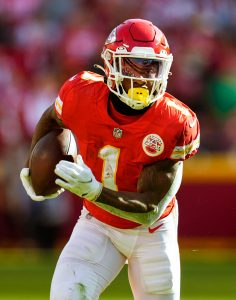 Although McKinnon has not seen a contract close to the one the 49ers gave him in 2018, he has been an undeniable success story in a bleak period for the position. The Chiefs have now given McKinnon three one-year contracts, and it is interesting this one did not require much of a raise from 2022. Then again, the market was unkind to most backs this year.
Although McKinnon has not seen a contract close to the one the 49ers gave him in 2018, he has been an undeniable success story in a bleak period for the position. The Chiefs have now given McKinnon three one-year contracts, and it is interesting this one did not require much of a raise from 2022. Then again, the market was unkind to most backs this year.
McKinnon became a valuable piece for the Chiefs, setting a post-merger NFL running back record by catching a touchdown pass in six straight games. McKinnon’s nine receiving TDs broke a Chiefs single-season RB standard as well, and his 10 total TDs marked a career high for the one-time Adrian Peterson Vikings successor.
Whiffing on Clyde Edwards-Helaire, a first-rounder who was supposed to become a dynamic aerial option for Mahomes, the Chiefs have both rectified the situation with McKinnon and dealt another blow to RB value in doing so. While most teams cannot get away with giving the keys to a seventh-round pick (Isiah Pacheco) and a 31-year-old back on veteran-minimum money, Mahomes’ presence affords the Chiefs luxuries. This low-cost duo comprising the Chiefs’ playoff backfield undoubtedly affected teams’ thinking at the position this offseason.
McKinnon, who missed two full 49ers seasons after signing a four-year deal worth $28MM, played in every Chiefs game last season. The ex-Vikings draftee has made his most valuable contributions in his NFL twilight years.
Notable losses:
- Orlando Brown Jr., T
- Michael Burton, FB
- Frank Clark, DE (released)
- Carlos Dunlap, DE
- Mecole Hardman, WR
- Darius Harris, LB
- Chad Henne, QB (retired)
- Ronald Jones, RB
- Khalen Saunders, DT
- JuJu Smith-Schuster, WR
- Juan Thornhill, S
- Brandon Williams, DT
- Andrew Wylie, OL
The Chiefs had wanted to retain Brown, but they passed on tagging him a second time (at a cost of $19.9MM). If Donovan Smith proves a significant downgrade at the O-line’s glamour position, not re-tagging Brown — a move believed to be in play for a bit — will look like a questionable strategy. Then again, a Brown tag would have almost definitely prevented the Taylor signing. Brown made his way to Cincinnati, and while the overall contract number did not match what the Chiefs proposed before the July 2022 tag extension deadline, the sixth-year blocker still made out well.
The Colts’ stunning 2021 season-ender in Jacksonville seems does not exactly seem like it occurred 20 months ago. So much has changed since. Although the batch of Pro Bowlers (minus one well-documented exception) from that talented team remains ahead of the 2023 season, they have observed a chaotic overhaul in the time since that crushing Jaguars loss. The Quenton Nelson-, DeForest Buckner– and Kenny Moore-fronted cast are now part of a rebuilding team, with a new coaching staff and another new quarterback in place.
While multiple All-Pros remain on Indianapolis’ roster, last year’s second-half trainwreck highlighted Jim Irsay‘s increasingly prominent role in this franchise’s fortunes. From quarterback directives to a historically bizarre coaching development, the owner has involved himself significantly since the Jacksonville upset. The Jonathan Taylor saga brought Irsay’s meddling to a crisis point, and it has overshadowed the other Colts developments entering the season.
Free agency additions:
- Matt Gay, K: Four years, $22.5MM ($10.1MM guaranteed)
- Samson Ebukam, DE: Three years, $24MM ($10.76MM guaranteed)
- Gardner Minshew, QB: One year, $3.5MM ($3.5MM guaranteed)
- Taven Bryan, DT: One year, $3.51MM ($3MM guaranteed)
- Chris Lammons, CB: One year, $1.1MM
- Isaiah McKenzie, WR: One year, $1.1MM
- Jacob Martin, DE: One year, $1.23MM
- Al-Quadin Muhammad, DE: One year, $371K (practice squad)
- Ronnie Harrison, S: One year, $290K (practice squad)
Other unstable roster and staff components have dwarfed the Colts’ kicker trouble, but the team did not skimp when it came to addressing this troublesome area. Two tours of Chase McLaughlin — as the Adam Vinatieri emergency successor in 2019 and Rodrigo Blankenship‘s replacement last year — did not move Chris Ballard to retain him. Instead, the seventh-year GM authorized the NFL’s second-most lucrative kicker contract to bring over Gay from Los Angeles.
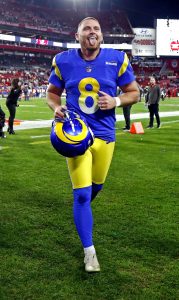 The small gap between Gay and Justin Tucker‘s AAVs ($5.6MM, $6MM) point to the latter being undervalued, but Gay enjoyed the opportunity to hit free agency. As the Rams retooled around league-minimum specialty contracts, Gay will leave one favorable kicker environment for another.
The small gap between Gay and Justin Tucker‘s AAVs ($5.6MM, $6MM) point to the latter being undervalued, but Gay enjoyed the opportunity to hit free agency. As the Rams retooled around league-minimum specialty contracts, Gay will leave one favorable kicker environment for another.
Gay only served as the Rams’ full-time kicker from 2021-22, catching on midway through the 2020 season. But he drilled at least 93% of his field goal tries in each of the past two seasons. This included an 11-for-14 make rate from 50-plus yards. The Colts once fixed their swiftly developing kicker unreliability by replacing Mike Vanderjagt with Vinatieri during the 2006 free agency period. Gay, 29, will be tasked with stopping a revolving door post-Vinatieri.
From a pass-rushing standpoint, Ebukam is a clear downgrade from Yannick Ngakoue. One of the 2021 Colts’ flaws came from the team not sufficiently replacing Justin Houston, leaving Kwity Paye too great a task as a rookie. Paye took a step forward last season, upping his sack (six) and tackle-for-loss totals (10) from his rookie season despite missing five games. The 2021 first-round pick now slides back into the top edge-rushing role for the Colts, with Ebukam a Nick Bosa sidekick for the past two seasons.
Ebukam, 28, has bettered Paye’s QB-hit totals in each of the past two years, combining for 24 as a 49er, but he has never topped five sacks in any of his six seasons — despite playing with Bosa and Aaron Donald throughout that span. A modest statistical resume aside, Ebukam’s 49ers work generated a better market compared to his 2021 post-Rams free agency foray. Among free agent edges, only the Titans’ Arden Key pickup required more guaranteed money ($13MM). Ebukam’s guarantee figure beat out Ngakoue, ex-teammates Leonard Floyd and Charles Omenihu, along with Marcus Davenport and Frank Clark.
The Colts finished with 44 sacks last season; Ngakoue’s 9.5 helped Gus Bradley‘s defense rank in the top half in scoring during a 4-12-1 season. During the year in between Houston and Ngakoue, the Colts totaled 33 sacks. Ballard has come through with many impact starters in the second round of the draft, but he has missed on a few pass rushers. Kemoko Turay, Ben Banogu and Tyquan Lewis have not panned out. The team has a bad track record with this precise investment, with Dayo Odeyingbo (Round 2, 2021) tasked with turning it around. Odeyingbo figures to see more opportunities post-Ngakoue; the Purdue product totaled five sacks and 11 QB hits in his first full season. Martin and perhaps Muhammad, who tallied a career-high six sacks in 2021, will be tasked with aiding a Buckner-reliant pass rush.
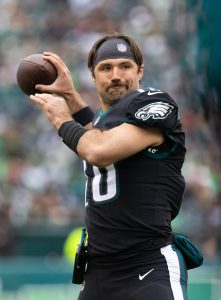 Had the Colts carried contender aspirations into this season, they would probably have aimed higher than Minshew. Rather than a bridge option, Minshew has become Anthony Richardson‘s backup. Minshew operating as the bridge to Richardson crumbled quickly, and the former Jaguars and Eagles passer will start another season on the bench.
Had the Colts carried contender aspirations into this season, they would probably have aimed higher than Minshew. Rather than a bridge option, Minshew has become Anthony Richardson‘s backup. Minshew operating as the bridge to Richardson crumbled quickly, and the former Jaguars and Eagles passer will start another season on the bench.
Shane Steichen coached Minshew for two seasons in Philadelphia, making for an ideal backup — even if Richardson and Minshew’s skillsets are not comparable. Nevertheless, Minshew backed up Jalen Hurts for two seasons and served as a Jaguars regular starter during the previous two. The former sixth-round pick has bucked the odds by making 24 career starts. While he is 8-16 in those games, several of the starts came for a terrible 2020 Jaguars team and one more came in a game featuring Eagles backups and Cowboys starters. Minshew carries a 44-to-15 TD-to-INT ratio into his fifth season and presents a higher floor compared to Richardson as a passer. Though, if the most polished of the Colts’ passers makes any starts this season, something has gone wrong.
Re-signings:
- E.J. Speed, LB: Two years, $8MM ($3.92MM guaranteed)
- Ashton Dulin, WR: Two years, $7.2MM ($3.5MM guaranteed)
- Tyquan Lewis, DL: One year, $2.1MM ($500K guaranteed)
- Deon Jackson, RB: One year, $940K
Speed’s re-signing comes a year after the Colts retained Zaire Franklin. With Leonard attached to the second-highest off-ball linebacker salary, the Colts have let both Bobby Okereke and Anthony Walker walk. But Speed and Franklin are still around on lower-middle-class accords. A fifth-round pick out of Division II Tarleton State, Speed worked mostly as a special-teamer from 2019-21 but served as a five-game starter last season. His seven tackles for loss revealed promise, and Okereke’s exit opens the door for more defensive reps alongside Leonard and Franklin.
 Leonard battled three injuries last year and underwent two back surgeries in 2022, the second of which ending his abbreviated season early. One of this century’s most productive off-ball ‘backers, Leonard was limited to just three games last year. After playing through that back issue en route to a third first-team All-Pro honor in 2021, Leonard ran into a midcareer crossroads of sorts. He also missed 2022 time due to a concussion and a nose injury. The Colts are not out of the woods yet with Leonard health trouble. The sixth-year veteran suffered a concussion during a joint practice with the Bears, leaving him in the protocol days before Week 1.
Leonard battled three injuries last year and underwent two back surgeries in 2022, the second of which ending his abbreviated season early. One of this century’s most productive off-ball ‘backers, Leonard was limited to just three games last year. After playing through that back issue en route to a third first-team All-Pro honor in 2021, Leonard ran into a midcareer crossroads of sorts. He also missed 2022 time due to a concussion and a nose injury. The Colts are not out of the woods yet with Leonard health trouble. The sixth-year veteran suffered a concussion during a joint practice with the Bears, leaving him in the protocol days before Week 1.
Taylor’s placement on the Colts’ reserve/PUP list opens the door for Jackson and others to complement Richardson in the run game. Zack Moss is uncertain to open the season as well, having suffered a broken arm during training camp. Moss is not on IR, however, pointing to a September re-emergence from the 2022 trade acquisition. A former UDFA, Jackson started two games in relief of Taylor last year but finished his season with a 3.5-yard rushing average.
The Colts, who brought in Kareem Hunt last month but did not sign him, signed and then quickly released Kenyan Drake. As it stands now, Jackson and fifth-round rookie Evan Hull represent Indy’s healthy RB options. Going into his fifth season with the Colts, Dulin will not play in 2023. An ACL tear sidelined the veteran backup wide receiver in August.
Notable losses:
- Ben Banogu, DE
- Rashod Berry, DE (waived)
- Parris Campbell, WR
- Brandon Facyson, CB
- Nick Foles, QB (released)
- Matt Haack, P
- Dennis Kelly, T
- Chase McLaughlin, K
- Rodney McLeod, S
- Yannick Ngakoue, DE
- Bobby Okereke, LB
- Matt Pryor, OL
- Isaiah Rodgers, CB (waived)
- Matt Ryan, QB (released)
- Armani Watts, S
For a few days in March 2022, the Colts carried neither a starter-caliber quarterback nor a first-round pick. Irsay demanded Ballard trade Wentz, despite the Colts having given up first- and third-round picks for him in 2021, and the owner was believed to have ordered his GM to finalize the Ryan trade. The Colts’ combined tally for Wentz and Ryan: a first-round pick and two third-rounders for two thirds. While Wentz became a punching bag for Irsay and others, he fared far better than Ryan in Indianapolis. Now with CBS, Ryan appeared at the end of the line in Indy.
 The Colts had planned to stop their QB carousel for a bit with Ryan, whom Ballard wanted to start for at least two seasons. Two years remained on Ryan’s Falcons-constructed contract — one the Colts reworked upon acquiring him — but it quickly became apparent the former MVP would not be even a temporary answer in Indianapolis. As the Colts’ O-line struggled to reach its expected form, Ryan took 38 sacks in 12 games and fumbled a career-high 15 times. Irsay again stepped in, instructing Reich to bench Ryan for the unseasoned Sam Ehlinger. Reich reluctantly did so, while believing Ehlinger was unready. After Irsay fired Reich, he gave the OK for interim HC Jeff Saturday to reinstall Ryan as the starter.
The Colts had planned to stop their QB carousel for a bit with Ryan, whom Ballard wanted to start for at least two seasons. Two years remained on Ryan’s Falcons-constructed contract — one the Colts reworked upon acquiring him — but it quickly became apparent the former MVP would not be even a temporary answer in Indianapolis. As the Colts’ O-line struggled to reach its expected form, Ryan took 38 sacks in 12 games and fumbled a career-high 15 times. Irsay again stepped in, instructing Reich to bench Ryan for the unseasoned Sam Ehlinger. Reich reluctantly did so, while believing Ehlinger was unready. After Irsay fired Reich, he gave the OK for interim HC Jeff Saturday to reinstall Ryan as the starter.
In order to avoid injury guarantees ramping up their Ryan dead money by an additional $7.2MM, the Colts benched him again — for Nick Foles — for Week 16. While that was probably Ryan’s final act as an NFL player, Foles appeared a shell of his Eagles version when called upon. Averaging only 5.3 yards per attempt, Foles finished with no touchdown passes and four interceptions. After the former Super Bowl MVP inked a two-year, $6.2MM deal with the Colts, no team has signed the 11-year vet.
Ngakoue is not on a Hall of Fame track and has been viewed as a run-game liability, helping explain him being on team No. 6. But the longtime Bradley pupil continued his impressive streak in Indianapolis. Last season marked Ngakoue’s seventh straight year with at least eight sacks; no NFLer is riding such a streak. The Colts let it be known early in the offseason they were not re-signing Ngakoue, despite retaining Bradley, and he ended up with the Bears on a one-year, $10.5MM contract.
After expressing quick regret on his initial hire as Panthers owner, David Tepper reversed course and prioritized NFL experience. Carolina bailed midway through Year 3 on Matt Rhule‘s seven-year contract, and despite Steve Wilks‘ admirable job moving the team back into the mix for a division title (albeit in a historically bad NFC South), Frank Reich became the pick.
That move sets the tone for Carolina’s mid-2020s, but the decision Reich, Tepper and GM Scott Fitterer made barely a month later should have a longer-term impact. After a quarterback carousel spun in Charlotte for several seasons, the team did its best to address one of the NFL’s most glaring needs.
Trades:
- Sent Bears WR D.J. Moore, Nos. 9 and 61, along with 2024 first-, 2025 second-round pick for No. 1 overall pick
 Cam Newton‘s MVP 2015 season turned out to be an aberration; the talented dual-threat option gradually trended down in the years following Carolina’s Super Bowl 50 loss. Toward the end of that late-2010s period, Newton began to break down. Shoulder and foot injuries led to the Panthers cutting bait on his 2015 extension in 2020, but the three-year, $63MM Teddy Bridgewater contract became one of a few stopgap measures that destabilized the team.
Cam Newton‘s MVP 2015 season turned out to be an aberration; the talented dual-threat option gradually trended down in the years following Carolina’s Super Bowl 50 loss. Toward the end of that late-2010s period, Newton began to break down. Shoulder and foot injuries led to the Panthers cutting bait on his 2015 extension in 2020, but the three-year, $63MM Teddy Bridgewater contract became one of a few stopgap measures that destabilized the team.
Rhule traded Bridgewater in 2021, and the Panthers offered a top-10 pick and their 2020 QB1 for Matthew Stafford in 2021. The Panthers believed they had secured a Stafford trade that winter (though, the then-Lions QB was not too keen on such a move), but the Rams swooping in led to a subsequent trade for Sam Darnold. An injury-plagued Darnold year keyed the Rhule-directed Baker Mayfield push. The Mayfield move only came about after Tepper’s two-offseason pursuit of Deshaun Watson failed. Watson was not big on the Panthers, and they joined the Falcons and Saints in balking at matching the Browns’ fully guaranteed extension offer. Since Newton’s 2018 shoulder injury shut him down, the Panthers have started seven QBs.
 This offseason did not turn into a Bryce Young-centric effort immediately. The Panthers pursued Derek Carr, meeting with the nine-year Raiders passer at the Combine — shortly after Carr wielded his no-trade clause to finalize a release. And they were still in those sweepstakes days before going in another direction. But the team shied away from Carr’s $35MM-per-year asking price, clearing the way for the Saints to meet it.
This offseason did not turn into a Bryce Young-centric effort immediately. The Panthers pursued Derek Carr, meeting with the nine-year Raiders passer at the Combine — shortly after Carr wielded his no-trade clause to finalize a release. And they were still in those sweepstakes days before going in another direction. But the team shied away from Carr’s $35MM-per-year asking price, clearing the way for the Saints to meet it.
Initially, the Bears were looking at moving from No. 1 to No. 2 to No. 9 — a complex trade that would have given the Texans the top pick and the Panthers the second overall choice. But Houston drifted out of the picture, leading to direct Chicago-Carolina negotiations. Bears GM Ryan Poles asked about Brian Burns and Derrick Brown, but after Fitterer kept the young front-seven pieces out of the trade, Chicago insisted Moore be part of the package. Despite Moore anchoring the Panthers’ receiving corps for most of his five-year Charlotte run, that did not prove a dealbreaker. The Panthers had extended Moore — on a three-year, $61.8MM deal — in March 2022; that contract is now on the Bears’ payroll.
The Panthers needed to include Moore to separate themselves from the other suitors for the pick, making the reluctant decision despite previously turning down a first-rounder (in different trade talks) for their No. 1 wide receiver. Moore, 26, joins Steve Smith and Muhsin Muhammad as the only three-time 1,100-yard receivers in franchise history. Smith and Muhammad enjoyed better QB stability than Moore, who did not begin his 1,100-yard string until Kyle Allen took over for Newton in 2019.
 Carolina also preferred to retain the higher of its two 2023 second-round picks. Rather than move their own choice (No. 38), the Panthers gave the Bears the pick obtained in the Christian McCaffrey deal (No. 61) and a 2025 second. It can be argued the Panthers overprotected their own 2023 second-rounder (which became wideout Jonathan Mingo), keeping it and instead trading No. 61 and a 2025 second.
Carolina also preferred to retain the higher of its two 2023 second-round picks. Rather than move their own choice (No. 38), the Panthers gave the Bears the pick obtained in the Christian McCaffrey deal (No. 61) and a 2025 second. It can be argued the Panthers overprotected their own 2023 second-rounder (which became wideout Jonathan Mingo), keeping it and instead trading No. 61 and a 2025 second.
Regardless of how they stuck the landing, the Panthers made a true QB commitment for the first time since extending Newton in 2015. As a result, Young and Justin Fields‘ careers will be tied together for a while. With Poles and Fitterer boldly completing this trade before free agency, the Panthers carried more certainty going into the market compared to the Bears, who had traded a No. 1 overall pick earlier in an offseason than anyone since the draft moved to April in 1976. It did not take too long before the Panthers’ Young preference circulated.
Free agency additions:
- Adam Thielen, WR: Three years, $25MM ($14MM guaranteed)
- Miles Sanders, RB: Four years, $25.4MM ($13MM guaranteed)
- Hayden Hurst, TE: Three years, $21.75MM ($13MM guaranteed)
- Shy Tuttle, DT: Three years, $19.5MM ($13MM guaranteed)
- Andy Dalton, QB: Two years, $10MM ($8MM guaranteed)
- Vonn Bell, S: Three years, $22.5MM ($7.5MM guaranteed)
- Justin Houston, OLB: One year, $6MM ($6MM guaranteed)
- D.J. Chark, WR: One year, $5MM ($5MM guaranteed)
- DeShawn Williams, DL: One year, $1.75MM ($1.75MM guaranteed)
- Kamu Grugier-Hill, LB: One year, $1.32MM ($153K guaranteed)
- Troy Hill, CB: One year, $1.27MM ($50K guaranteed)
The Moore trade keyed a receiver reboot in Carolina. After Moore and the then-Robbie Anderson began the past three seasons as the Panthers’ top wideouts, both ended up in trades. The team’s ensuing plan injects more risk into the equation, with Thielen going into his age-33 season and Chark missing sizable chunks of the past two slates due to injuries.
 Parting with a number of core contributors to improve their cap situation, the Vikings ditched Thielen after 10 years. The Division II product-turned-rookie-camp body made a stunning ascent to join Randy Moss, Cris Carter and Anthony Carter near the top of all-time Vikings receiving lists, and the Minnesota native enjoyed a market upon being cut. The Broncos and Cowboys were among the teams to pursue Thielen, but the 11th-year pass catcher signed with the Panthers after a visit. The Panthers provided a quality parachute for Thielen, who collected nearly as much guaranteed money as top 2023 receiver UFAs Jakobi Meyers and JuJu Smith-Schuster ($16MM apiece) despite being seven years older than both.
Parting with a number of core contributors to improve their cap situation, the Vikings ditched Thielen after 10 years. The Division II product-turned-rookie-camp body made a stunning ascent to join Randy Moss, Cris Carter and Anthony Carter near the top of all-time Vikings receiving lists, and the Minnesota native enjoyed a market upon being cut. The Broncos and Cowboys were among the teams to pursue Thielen, but the 11th-year pass catcher signed with the Panthers after a visit. The Panthers provided a quality parachute for Thielen, who collected nearly as much guaranteed money as top 2023 receiver UFAs Jakobi Meyers and JuJu Smith-Schuster ($16MM apiece) despite being seven years older than both.
Thielen, whose 30 touchdown receptions since 2020 trail only Davante Adams, Mike Evans and Tyreek Hill. Granted, Thielen benefited extensively from Justin Jefferson‘s meteoric rise. But the veteran possession receiver should still aid Young as he acclimates to the NFL. This is a true multiyear commitment. In a non-post-June 1 capacity, cutting Thielen would not save the Panthers any money in 2024. Reich and Co. are betting on two solid years from Thielen.
The Lions attempted to re-sign Chark, but he will be part of a third team in three years. The ex-Jaguars second-rounder posted a 1,000-yard season with Gardner Minshew primarily at the controls (2019) and did some field-stretching work for the Lions when available last year. But Chark missed 13 games because of a fractured ankle in 2021 and saw more ankle trouble lead him to IR last season. Chark still averaged 16.7 yards per reception in his Lions one-off — the second-highest total of his career — but the $5MM contract reflects teams’ hesitancy on the injury front. Chark underwent another ankle surgery this offseason; this second “prove it” deal will be pivotal for the LSU alum’s earning power.
 Both Mike Gesicki and Dalton Schultz received the franchise tag last season and have been superior receivers to Hurst during their careers. Hurst, 30, is also two years older than Gesicki and three years older than Schultz. The Panthers nevertheless made another true multiyear commitment. Hurst has one career 500-yard receiving season — a 571-yard showing with the 2020 Falcons — and is coming off a 414-yard slate in Cincinnati. PFF also rated Schultz as a far superior run blocker last season. With the Bengals and Falcons over the past two seasons, Hurst did not exceed nine yards per reception.
Both Mike Gesicki and Dalton Schultz received the franchise tag last season and have been superior receivers to Hurst during their careers. Hurst, 30, is also two years older than Gesicki and three years older than Schultz. The Panthers nevertheless made another true multiyear commitment. Hurst has one career 500-yard receiving season — a 571-yard showing with the 2020 Falcons — and is coming off a 414-yard slate in Cincinnati. PFF also rated Schultz as a far superior run blocker last season. With the Bengals and Falcons over the past two seasons, Hurst did not exceed nine yards per reception.
The Panthers have not effectively replaced Greg Olsen since his foot trouble keyed a late-2010s decline. They will be making an interesting bet on Hurst doing so, but he and Thielen represent pivotal parts of Young’s first NFL attack.
As you may have heard, the NFL collectively updated its view of running backs. On that note, Sanders was fairly fortunate to land the deal he did. The four-year Eagles starter collected the most guaranteed money of any RB this offseason, though his AAV checked in south of James Conner and Leonard Fournette‘s 2022 pacts. Although Sanders will reunite with ex-Eagles RBs coach Duce Staley, who helped steer him to the Panthers, he is going from perhaps the NFL’s best offensive line to a middling unit. Saquon Barkley‘s Penn State successor is coming off a career-best (by a wide margin) 1,269 rushing yards and 11 touchdowns. He also has not totaled more than 200 receiving yards in a season since 2019. But there should be some pass-catching upside for the Panthers to explore.
As aggressive New York Jets offseason saw the organization accelerate its timeline to 2023. While the 2022 iteration of the team had some warts, the Jets also showed significant progress during Robert Saleh‘s second season at the helm. The Jets had both the Offensive and Defensive Rookies of the Year in Garrett Wilson and Sauce Gardner, and with other promising young players up and down the roster, the Jets pushed their chips to the middle of the table.
After having received some of the worst QB play in the league during the 2022 campaign, the team made it a mission to improve the position in 2023. Gang Green improved it in a big way, acquiring a future Hall of Famer in Aaron Rodgers. The four-time MVP immediately adds credibility to an organization that’s desperate for respect, and it firmly puts the Jets on the playoff (if not Super Bowl) radar.
The Jets capitalized on their inexpensive core players by not only acquiring Rodgers. The team also brought in a number of championship-hungry veterans, including a number of Rodgers’ former Green Bay teammates. These transactions should be enough to guide the Jets back to the playoffs for the first time since 2010, but will it be enough to push them to the promised land?
Trades:
- Acquired QB Aaron Rodgers, fifth-round pick from Packers for 2o23 first-round swap, a second-round pick, a conditional 2024 second-rounder and 2023 sixth-round pick
- Traded WR Elijah Moore, 2023 third-round pick to the Browns for 2023 second-round pick
- Traded WR Denzel Mims, 2025 seventh-round pick to the Lions for conditional 2025 sixth-round pick
- Acquired S Chuck Clark from the Ravens for 2024 seventh-round pick
At one point, Zach Wilson was the crown jewel of the Jets’ rebuild. With GM Joe Douglas having loaded up on draft picks, Wilson was going to be the leader of an organically built squad. In natural Jets fashion, the BYU product failed to live up to expectations, leading the front office to look elsewhere at the position this offseason.
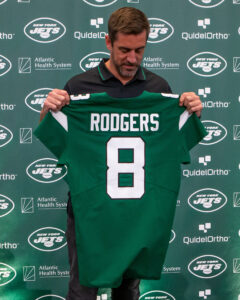 While the recent NFL team-building strategy has focused on spending around a rookie-contract QB, the Jets were in the unique position of having top-end rookie-level contracts elsewhere on the roster. Instead of restarting at the position via the draft, Douglas and Co. were motivated to compete now, and that was reflected in their rumored interest in many of the league’s available veteran quarterbacks.
While the recent NFL team-building strategy has focused on spending around a rookie-contract QB, the Jets were in the unique position of having top-end rookie-level contracts elsewhere on the roster. Instead of restarting at the position via the draft, Douglas and Co. were motivated to compete now, and that was reflected in their rumored interest in many of the league’s available veteran quarterbacks.
The Jets briefly flirted with Derek Carr before focusing their attention to the biggest name on the market: Aaron Rodgers. The Packers legend was clearly done in Green Bay and was considering his options, which included retirement. While Rodgers was still under contract with the Packers, he treated his decision like a pseudo-free agency, and he eventually declared his intention to play for the Jets.
After a month of negotiations, the veteran was traded to New York in a deal that ultimately netted Green Bay an improved 2023 first-round selection, a 2023 second-rounder and, in all likelihood, a 2024 first. Rodgers only needs to play 65% of the Jets’ 2023 offensive snaps for the Packers to collect a 2024 first. Suffice to say, the Packers did far better for Rodgers than they did when they sent Brett Favre to the Jets 15 years ago. That deal only ended up bringing the Pack a third-rounder.
Rodgers had one of his weakest seasons in 2022, putting together one of his lowest TD% (4.8) and one of his highest INT rates (2.2%) while finishing with the third losing record in his career (8-9). Of course, this would still be a massive improvement for the Jets’ offense, and Rodgers is only a year removed from back-to-back MVPs. Even if you no longer consider Rodgers one of the top QBs in the league, it appears he has enough in the tank for his age-40 season.
 The Jets weren’t done wheeling and dealing, with the front office moving on from a pair of former second-round WRs. Elijah Moore took a step back during his second season in the NFL, finishing with 446 receiving yards (vs. 538 as a rook) and one score (vs. five touchdowns). With the Jets adding a number of receivers to the roster (which we’ll get to below), Moore’s role with the organization was even more uncertain.
The Jets weren’t done wheeling and dealing, with the front office moving on from a pair of former second-round WRs. Elijah Moore took a step back during his second season in the NFL, finishing with 446 receiving yards (vs. 538 as a rook) and one score (vs. five touchdowns). With the Jets adding a number of receivers to the roster (which we’ll get to below), Moore’s role with the organization was even more uncertain.
The team ended up finding a taker, sending Moore to Cleveland. Moore had requested a trade last season, and while the Jets refused to move him at that point, they were more open to doing so with Rodgers and new wideouts onboard.
Mims was drafted a year before Moore but showed less through his three seasons in the NFL, hauling in a total 42 receptions for 676 yards. He was traded to the Lions for a conditional late-round pick. Detroit has since cut the wideout.
The Jets acquired Chuck Clark with the hope he’d play an important role on their secondary. The veteran only missed one start for the Ravens over the past three seasons, averaging around 92 tackles per season. Unfortunately, the March acquisition tore his ACL in June, ending his season before it even began. Clark’s injury ultimately led to the team’s signing of safety Adrian Amos.
Extensions and restructures:
- Signed QB Aaron Rodgers to two-year extension worth $75MM guaranteed
- Signed DT Quinnen Williams to a four-year, $96MM ($66MM guaranteed)
- Gave defensive end Carl Lawson pay cut, opening $12.7MM in cap space
Rodgers was attached to an untenable $107.5MM bill for the 2024 season, so the Jets made sure to adjust his contract upon completion of their trade with the Packers. The team ended up locking Rodgers into a two-year deal with $75MM guaranteed, a significant drop from the $100MM guaranteed he was set to see over the next two seasons. The contract also includes a nonguaranteed $37.5MM bill for 2025.
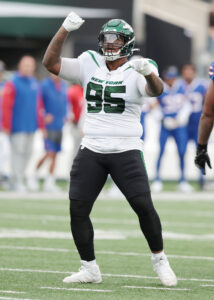 Despite indicating he was 90% retired earlier this year, Rodgers has stated a desire to continue playing beyond the 2023 season. His extension certainly increases the chances that he’ll be under center for the 2024 campaign (and without the hefty charge he was set to have under his ripped-up pact).
Despite indicating he was 90% retired earlier this year, Rodgers has stated a desire to continue playing beyond the 2023 season. His extension certainly increases the chances that he’ll be under center for the 2024 campaign (and without the hefty charge he was set to have under his ripped-up pact).
Elsewhere, the Jets are counting on Quinnen Williams to continue his rapid rise. After collecting 13 sacks between the 2020 and 2021 seasons, the defensive tackle showed off his top-three-pick pedigree in 2022, finishing with 12 sacks and 28 QB hits en route to a first-team All-Pro nod. The Jets rewarded the breakthrough season. Williams’ new deal ultimately slid in ahead of the other 2019 D-tackle draftees who had signed lucrative offseason deals. Both Williams and the Titans’ Jeffery Simmons secured more guaranteed money than Aaron Donald.
Carl Lawson helped the Jets carve out some extra space by reworking his expiring contract. The veteran agreed to a new deal partially tied to incentives. Lawson started all 17 games during his first season with the Jets and is expected to be a key defensive lineman in 2023. The Rodgers, Williams and Lawson agreements created significant cap space for the Jets.
Free agency additions:
- Allen Lazard, WR: Four years, $44MM ($22MM guaranteed)
- Dalvin Cook, RB: One year, $7MM ($5.8MM guaranteed)
- Mecole Hardman, WR: One year, $4.5MM ($3.58MM guaranteed)
- Wes Schweitzer, OL: Two years, $5MM ($3.16MM guaranteed)
- Quinton Jefferson, DL: One year, $3.6MM ($2.75MM guaranteed)
- Adrian Amos, S: One year, $1.75MM (fully guaranteed)
- Thomas Morstead, P: One year, $1.3MM ($1.09MM guaranteed)
- Billy Turner, OL: One year, $3.15MM ($1MM guaranteed)
- Al Woods, DT: One year, $2.25MM ($1MM guaranteed)
- Randall Cobb, WR : One year, $3MM ($250K guaranteed)
Rodgers made sure he did not come to New York alone. Before the Jets even finalized their latest QB trade with the Packers, the team added one of Rodgers’ preferred Green Bay options in Allen Lazard. After averaging 36 catches for 480 yards through the 2019 and 2021 seasons, Lazard became one of Rodgers’ favorite targets in 2022, hauling in 60 receptions for 788 yards and six touchdowns. Pro Football Focus has also graded Lazard as one of the league’s top blocking WRs in recent years, making him a dependable option even if he’s not the focal point of the offense.
Even after back-to-back 12-5 seasons, Mike McCarthy faces pressure going into his fourth year as Cowboys HC. The former Packers leader’s second-chance tenure has proven successful; he is the first Cowboys coach to guide the team to back-to-back playoff berths since Chan Gailey (1998-99). McCarthy will assume greater ownership of the team in Year 4 as well, taking over the play-calling reins after a split with OC Kellen Moore.
The Cowboys’ modest run of 21st-century postseason accomplishments is well known, turning up some heat on this rather popular team’s latest sideline boss. But Dallas’ latest roster does not present many weaknesses. The team addressed deficiencies via trades for accomplished veterans and is poised to enter this season healthier than it did in 2022. With the NFC again looking like the weaker conference (potentially by a wide margin), there are not many teams that outflank the Cowboys. That raises the stakes for McCarthy’s team to put it together in January.
Extensions and restructures:
- Reached fully guaranteed two-year, $36.85MM deal with G Zack Martin
- Extended CB Trevon Diggs on five-year, $97.5MM contract ($33.3MM guaranteed)
- Came to five-year, $86.8MM extension agreement with RT Terence Steele
- Gave S Malik Hooker three-year, $21MM extension ($11MM guaranteed)
- Restructured QB Dak Prescott‘s deal, creating $23MM in cap space
- Reworked T Tyron Smith‘s contract, creating $5MM in cap space
- Restructured WR Michael Gallup, DE DeMarcus Lawrence‘s contracts, creating $16MM in cap space
Joining Chris Jones in testing his team with a holdout, Martin incurred more than $1MM in nonwaivable fines (the 49ers’ Nick Bosa holdout differs, as teams can still waive fines for rookie-contract players). But the future Hall of Fame guard made the absence worthwhile. The Cowboys caved, and Martin cashed in despite two seasons having remained on his contract.
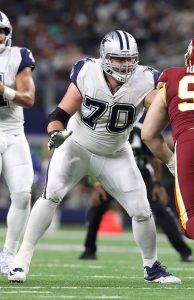 The Cowboys’ preference for five- or six-year extensions has led to a number of stalwarts playing out their primes and seeing peers elsewhere sign shorter-term contracts, allowing for a potential second big payday, and ultimately come out better. Dallas’ penchant for lengthy extensions reminds of how contracts were structured in previous eras, and coming into this year, only Dak Prescott earned a notable victory (via his four-year, $160MM extension) over management on this front.
The Cowboys’ preference for five- or six-year extensions has led to a number of stalwarts playing out their primes and seeing peers elsewhere sign shorter-term contracts, allowing for a potential second big payday, and ultimately come out better. Dallas’ penchant for lengthy extensions reminds of how contracts were structured in previous eras, and coming into this year, only Dak Prescott earned a notable victory (via his four-year, $160MM extension) over management on this front.
Martin entered the offseason tied to a six-year, $84MM deal. Agreed to in 2018, Martin’s contract set a guard record at the time. Given how NFL business works, lesser guards passed Martin. Chris Lindstrom, who does not have an All-Pro nod on his resume, joined Quenton Nelson in the $20MM-AAV guard club. This may or may not have been the last straw for Martin, who had fallen to the ninth-highest-paid guard following the Lindstrom pact.
Dallas’ 32-year-old O-line anchor did not skip minicamp but expressed disappointment in his contract before training camp and followed through on a rare holdout. The 2020 CBA deterred holdouts over its first three years, preventing teams from waiving fines for veterans who miss camp without excused absences. Although Jerry Jones‘ comments suggested a hardline stance, Martin ended up with an $8MM raise over two years and walked away with those final two seasons fully guaranteed. Martin had played out the guarantees on his previous deal.
For the All-Decade blocker to secure this package pointed to the value he brings the team. With Tyron Smith perennially injured and Travis Frederick retiring years ago, Martin represents the last link to the Tony Romo-era O-line core. Still in his prime protecting Prescott, the right guard struck a rare blow against the Cowboys’ contract M.O.
 The Cowboys came into camp prioritizing younger players’ contracts over Martin’s, with Diggs being one of the central priorities. Known for his aggressiveness, the former second-round pick produced a historic 2021 season (11 INTs — territory no one had reached since Everson Walls got there as a Cowboys rookie in 1981) that ended with first-team All-Pro acclaim. Diggs’ passer rating against and completion percentage allowed figures skyrocketed in 2022, however. Citing the corner’s yards yielded in coverage, Pro Football Focus has yet to rank Diggs as a top-40 player at the position. The Cowboys are convinced in Diggs, for the foreseeable future at least, giving the former second-round pick an upper-crust extension.
The Cowboys came into camp prioritizing younger players’ contracts over Martin’s, with Diggs being one of the central priorities. Known for his aggressiveness, the former second-round pick produced a historic 2021 season (11 INTs — territory no one had reached since Everson Walls got there as a Cowboys rookie in 1981) that ended with first-team All-Pro acclaim. Diggs’ passer rating against and completion percentage allowed figures skyrocketed in 2022, however. Citing the corner’s yards yielded in coverage, Pro Football Focus has yet to rank Diggs as a top-40 player at the position. The Cowboys are convinced in Diggs, for the foreseeable future at least, giving the former second-round pick an upper-crust extension.
Like Amari Cooper‘s 2020 contract, the Diggs deal has a clear out after two years. The Cowboys would be hit with just $4MM in dead money by designating Diggs as a post-June 1 cut in 2025 or trading him after that date. The team certainly will hope for a better outcome on this accord, but it is fairly protected in the event Diggs’ gambling habit catches up to him on this big-ticket accord. The player the Cowboys drafted to replace Byron Jones ended up cashing in on the type of extension neither Jones nor former top-10 pick Morris Claiborne could score with the team.
Hooker’s extension gives the Cowboys three safeties signed in the $5-$7MM-per-year range, completing an interesting middle-class-veteran-based plan at a position the team struggled to staff for years. Joining Jayron Kearse and Donovan Wilson in a formidable three-safety set including a former sixth-round pick and two outside hires, Hooker is now on his third Cowboys contract. The former Colts first-rounder has gone from earning $920K per year in his first Cowboys season (2021) to a $3.5MM AAV (2022) to this deal. Hooker has shaken off the injury issues that plagued him in Indianapolis, missing only three games as a Cowboy, and, at 27, is squarely in his prime.
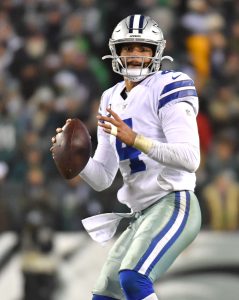 Although dozens of restructures took place this offseason, few carried greater ramifications than Prescott’s. The Cowboys saved plenty by moving money around on their top contract, but it arms the veteran quarterback with plenty of leverage once again. Prescott scored his monster extension, after three offseasons of negotiations, because of the trouble a second franchise tag would have caused for the Cowboys in 2021. Dak’s latest restructure spikes his 2024 cap number to $59.5MM. That is an untenable figure for the Cowboys, considering no one has ever played a season with a cap number higher than $45MM.
Although dozens of restructures took place this offseason, few carried greater ramifications than Prescott’s. The Cowboys saved plenty by moving money around on their top contract, but it arms the veteran quarterback with plenty of leverage once again. Prescott scored his monster extension, after three offseasons of negotiations, because of the trouble a second franchise tag would have caused for the Cowboys in 2021. Dak’s latest restructure spikes his 2024 cap number to $59.5MM. That is an untenable figure for the Cowboys, considering no one has ever played a season with a cap number higher than $45MM.
The Cowboys cannot tag Prescott in 2025, due to the whopping figure that could come about because of the two tags used previously (the second being for procedural purposes to prevent a 2025 tag), and the void years they tacked onto the deal would result in a $36.4MM dead-money hit were Dak to walk as a 2025 free agent. Although Prescott struggled for stretches last season, he is equipped for a bounce-back year — one that should vault him into the newly created $50MM-per-year salary club. Few players are in more advantageous financial situations.
Smith has finally reached the end of the NFL’s longest-running active contract. The All-Decade tackle did not exactly do poorly for earnings in his career, but signing an eight-year, $97.6MM extension in 2014 walled off his path to a lucrative third contract. Smith, who came into the league at 20, is still just 32. Had Smith signed even a five-year deal when first eligible, he would have been positioned to score another one more in line with the market changes (the cap rested at $133MM in 2014; it hit $224.8MM this year). Being attached to a $12.2MM-per-year extension, Smith would have been the NFL’s 27th-highest-paid tackle this year. The likely Hall of Famer’s injuries (45 missed games since 2016) led to the Cowboys effectively mandating a pay cut, but he will still beat the odds and finish out this contract.
Trades:
- Sent Texans 2023 fifth-round pick, 2024 sixth-rounder for WR Brandin Cooks
- Dealt 2024 fourth-round pick to 49ers for QB Trey Lance
- Acquired CB Stephon Gilmore from Colts for 2023 fifth-round pick
- Traded CB Kelvin Joseph to Dolphins for CB Noah Igbinoghene
The Cowboys’ public courtship of Odell Beckham Jr. produced nothing, as the former star ended up sitting out the 2022 season altogether. Prior to the Beckham push, however, the Cowboys discussed Cooks with the Texans. At that point, Houston was believed to want a second-round pick (Cooks’ cost back in 2020, when the Texans acquired him from the Rams). Dallas did not bite, and months later, it did not take anything on that level to pry the veteran away from the rebuilding team. While the Cowboys inquired on Jerry Jeudy and Adam Thielen, Cooks became their pick to upgrade the receiving corps.
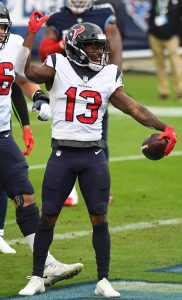 Michael Gallup did not deliver plus WR2 work last season, and the Cowboys missed Cooper alongside CeeDee Lamb. With Gallup nearly two years removed from his ACL tear, Cooks gives the team another nice three-WR set. Joining Brandon Marshall in accumulating 1,000-yard receiving seasons for four different teams, Cooks saw his numbers dip last season. He served as less of a deep threat in Houston, seeing his average depth of target drop under 11 in each of the past two seasons. Going into his age-30 season, Cooks should still have something left. Will the veteran speedster be able to threaten defenses deep consistently with a better quarterback?
Michael Gallup did not deliver plus WR2 work last season, and the Cowboys missed Cooper alongside CeeDee Lamb. With Gallup nearly two years removed from his ACL tear, Cooks gives the team another nice three-WR set. Joining Brandon Marshall in accumulating 1,000-yard receiving seasons for four different teams, Cooks saw his numbers dip last season. He served as less of a deep threat in Houston, seeing his average depth of target drop under 11 in each of the past two seasons. Going into his age-30 season, Cooks should still have something left. Will the veteran speedster be able to threaten defenses deep consistently with a better quarterback?
Dallas restructured Cooks’ contract, dropping his cap hit to $6MM this season through the use of void years. Should the 10th-year wide receiver be a post-prime commodity, the team can escape this contract — originally a two-year, $39MM Texans extension — for just $2MM in dead money in 2024 (as a post-June 1 cut). Considering the 2022 Cowboys only featured one 600-yard receiver — in a year in which they cycled through some options, including in-season addition T.Y. Hilton — sending the Texans two late-round picks for one of the league’s steadiest options was a move worth making.
Another move to indicate how the Cowboys view their championship window occurred just before the Cooks strike. Dallas will complement Diggs with Gilmore, giving the defense five players who have received first- or second-team All-Pro acclaim (along with Micah Parsons, DeMarcus Lawrence and Leighton Vander Esch). After an abbreviated 2021 season that involved a contract dispute and an eventual trade out of New England, the 2019 Defensive Player of the Year showed he still had gas in the tank in Indianapolis. The Colts’ coaching and QB performance obscured their other players’ work, and Gilmore graded as PFF’s No. 9 overall corner. Gilmore’s passer rating-against and completion percentage allowed numbers came in much better, despite the Colts’ struggles, than his 2021 output.


